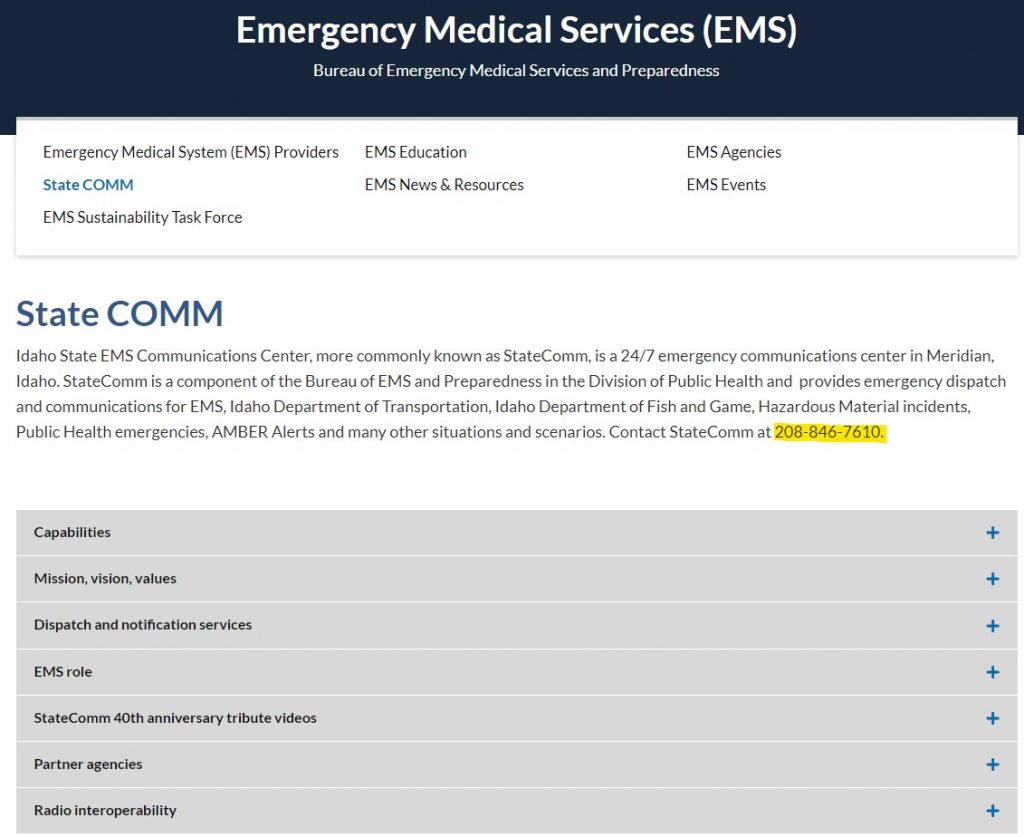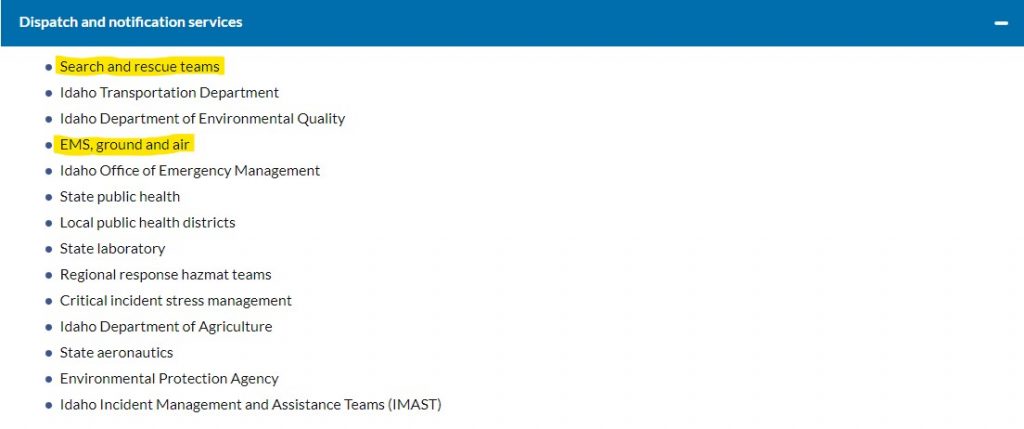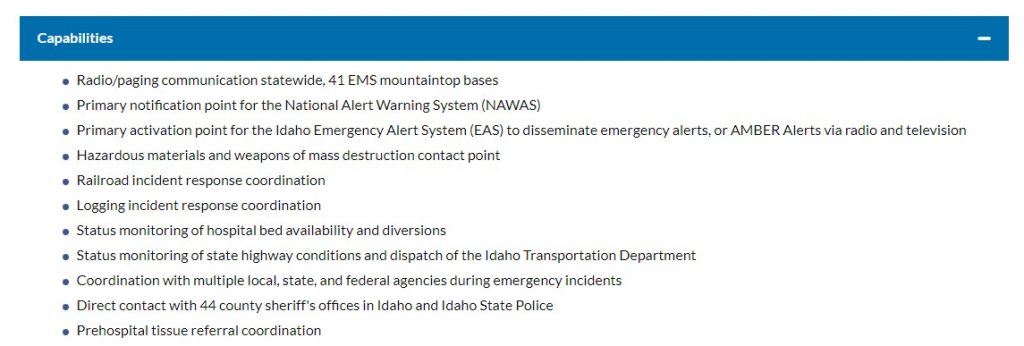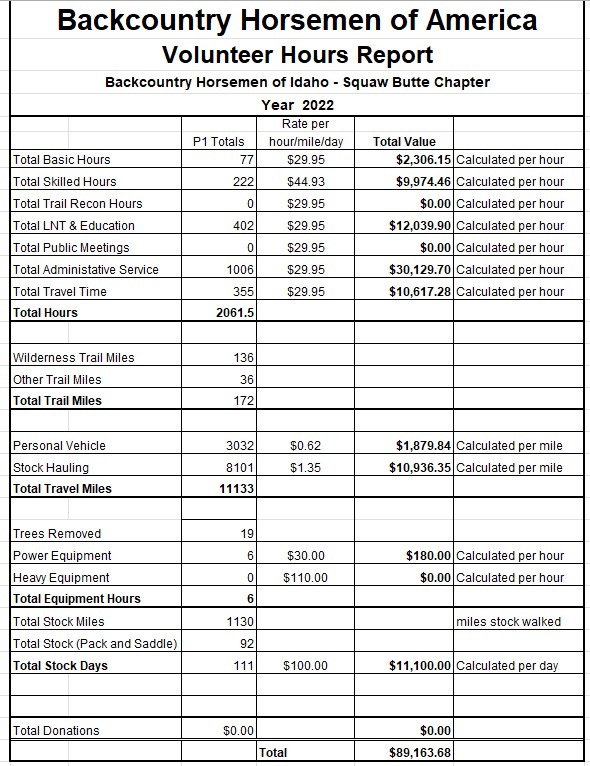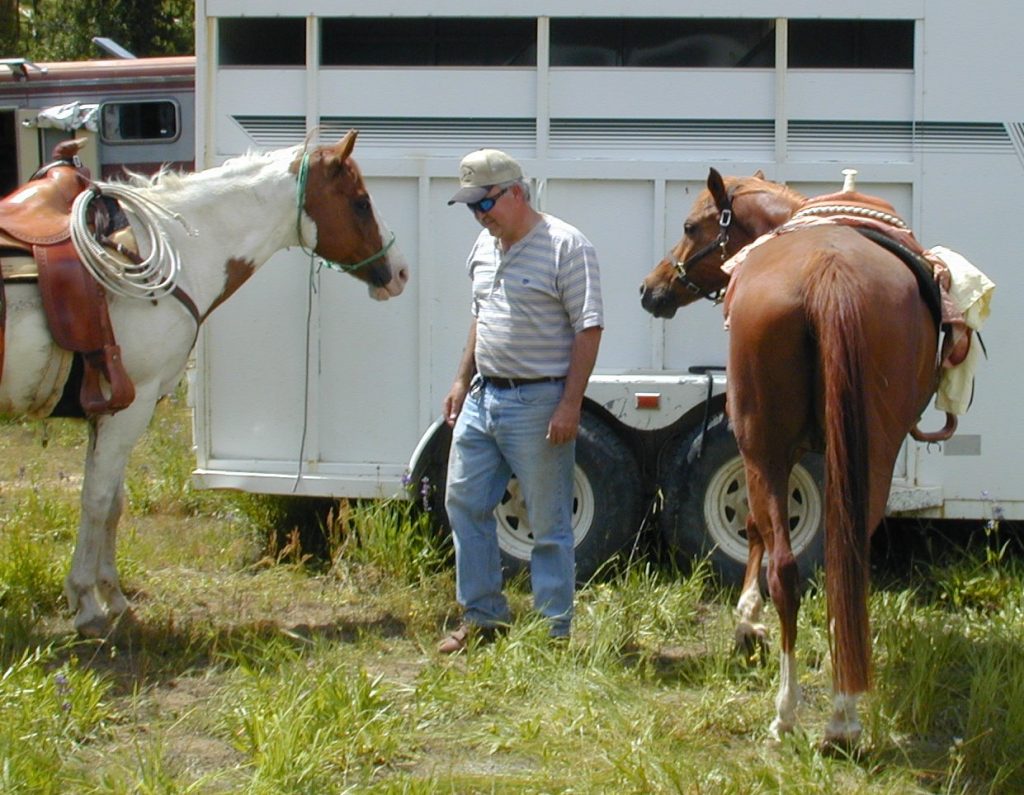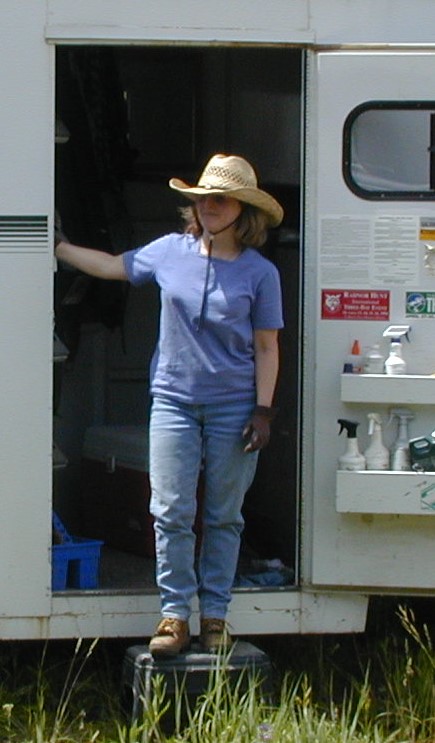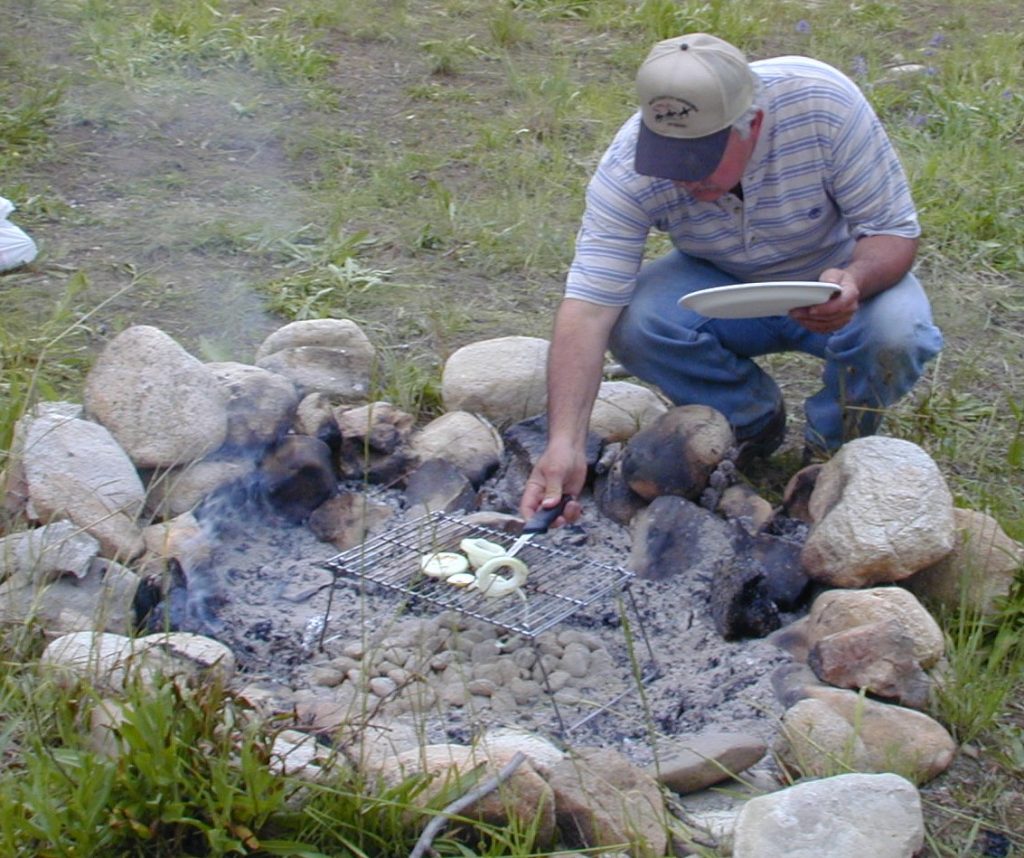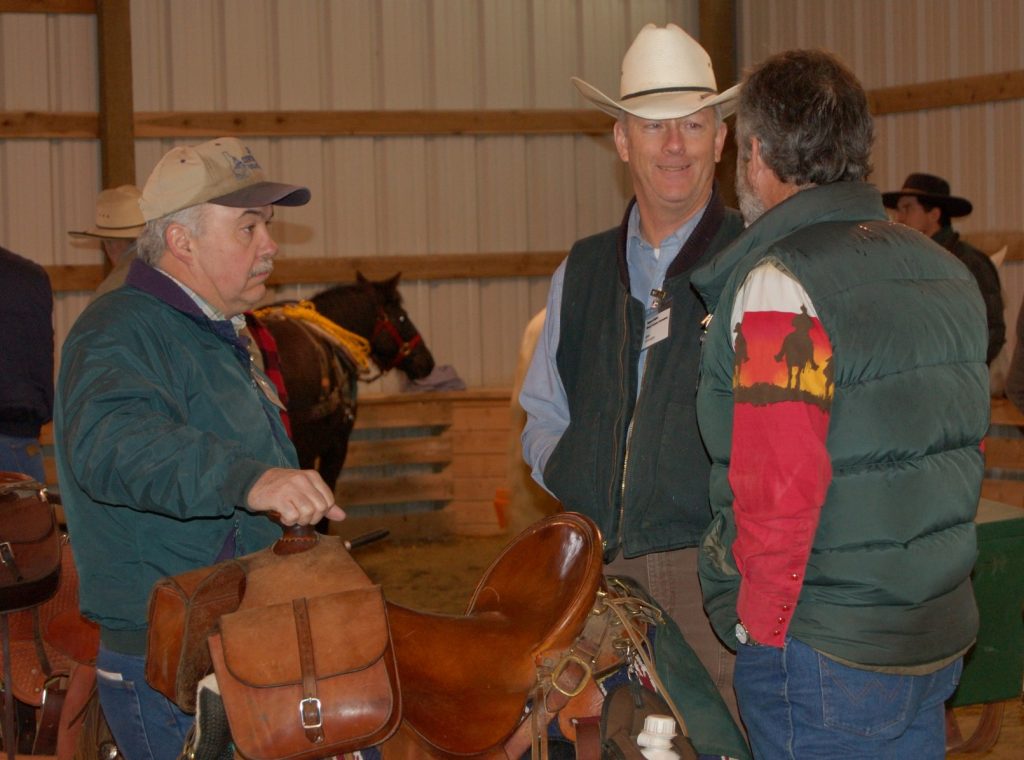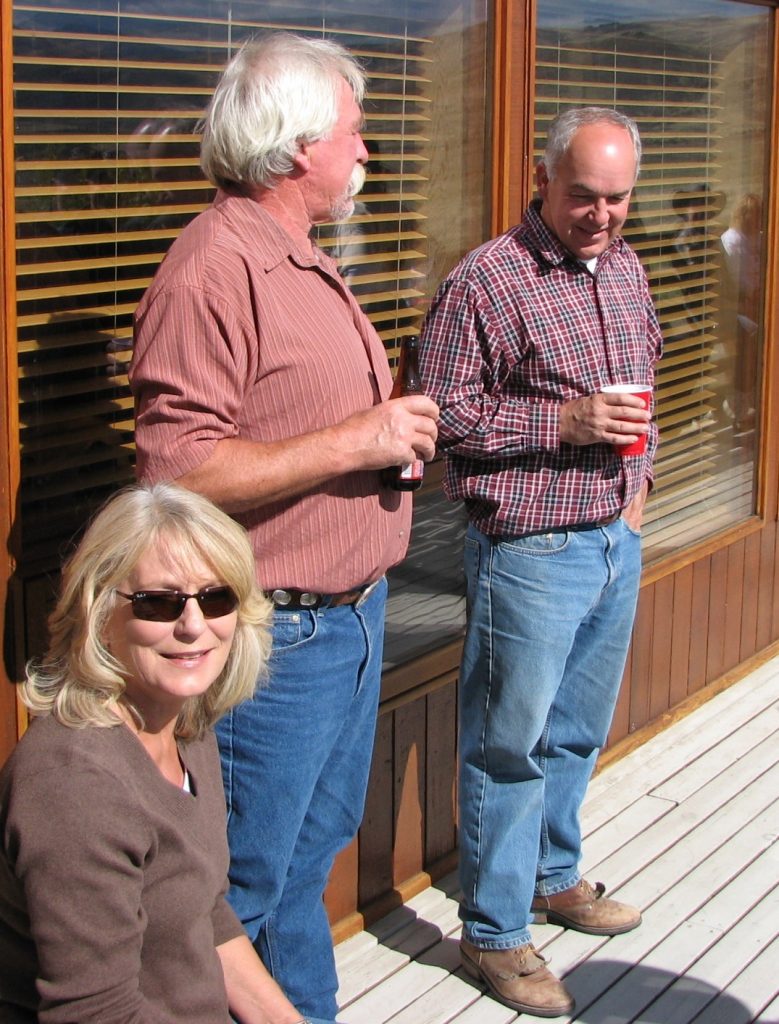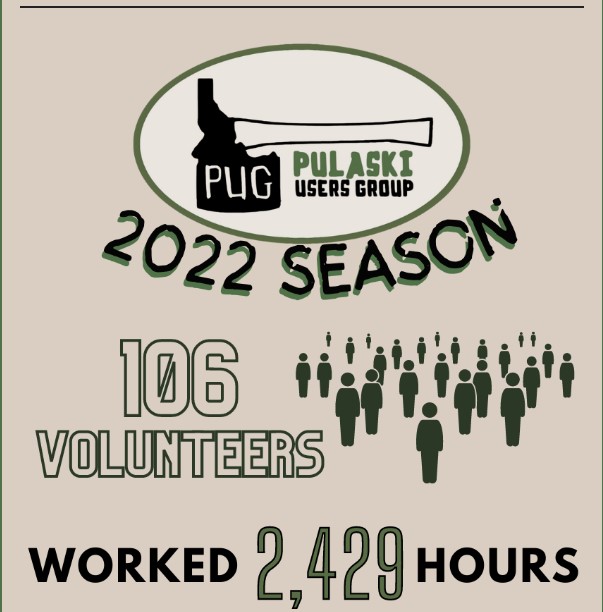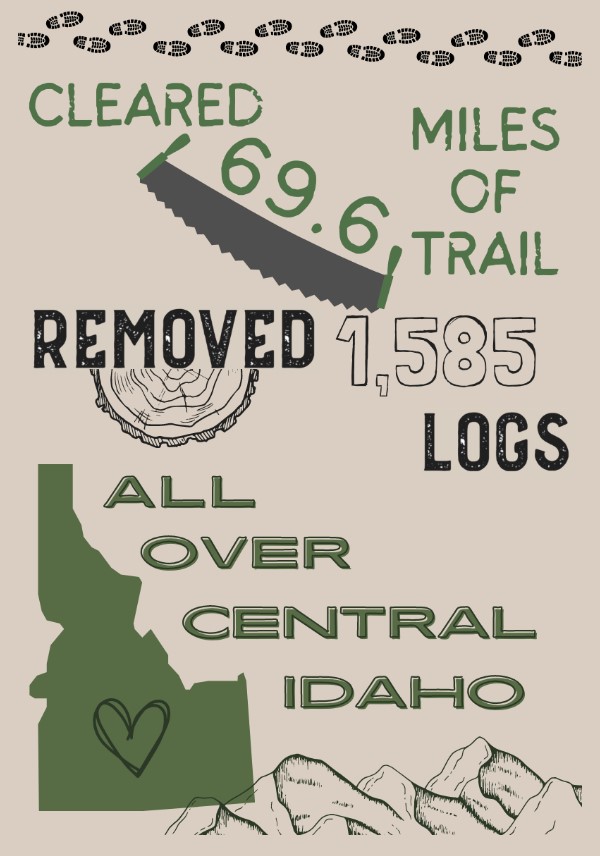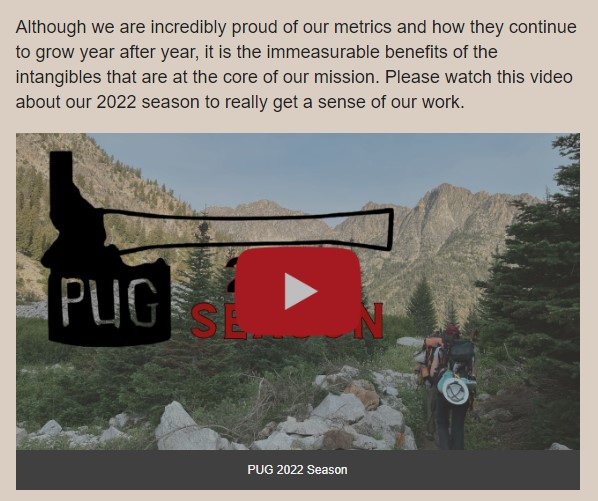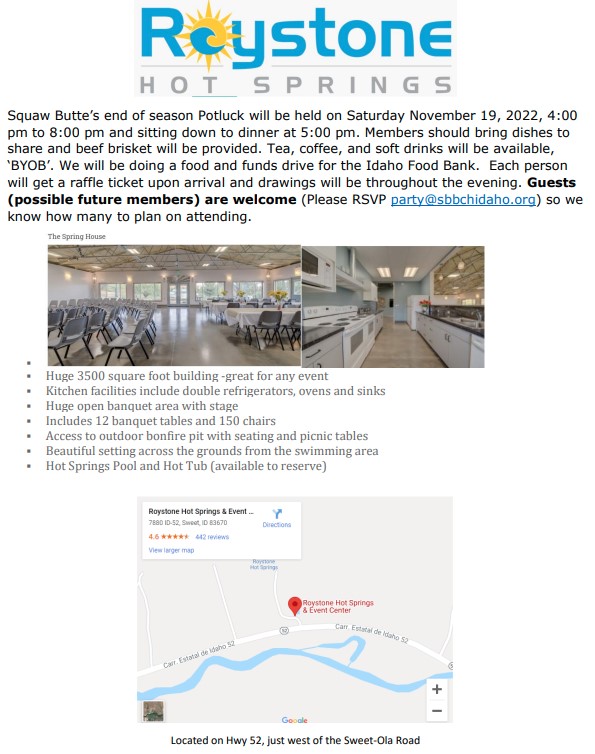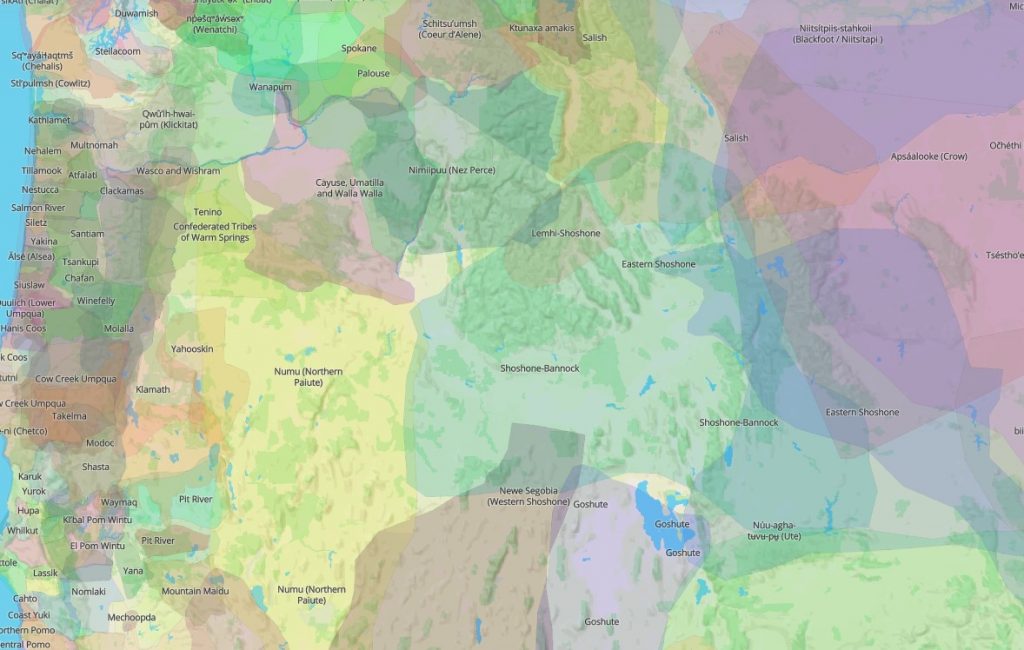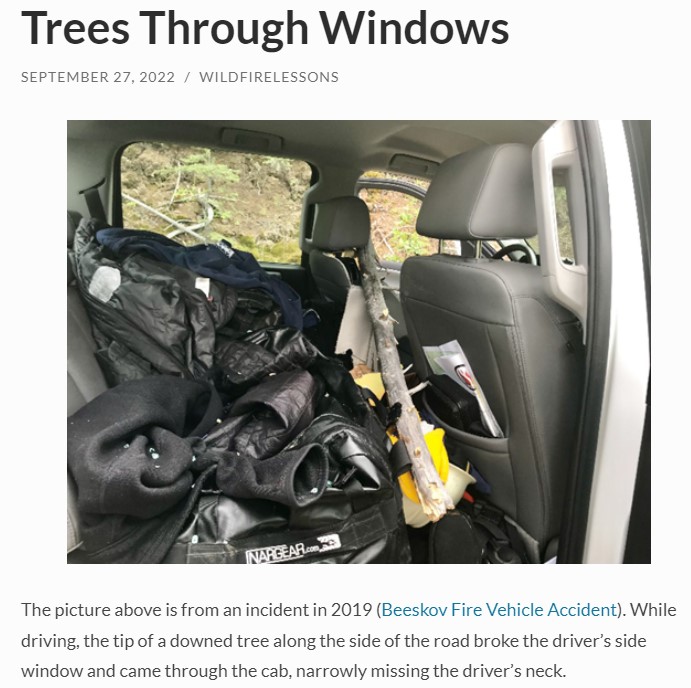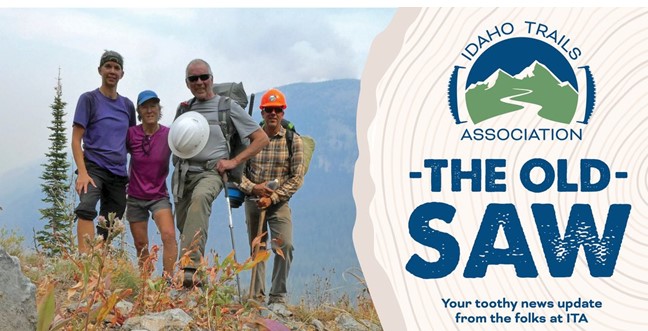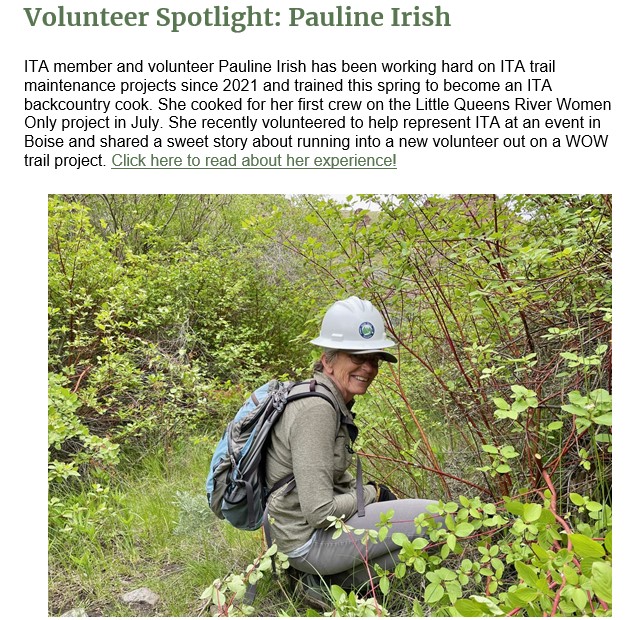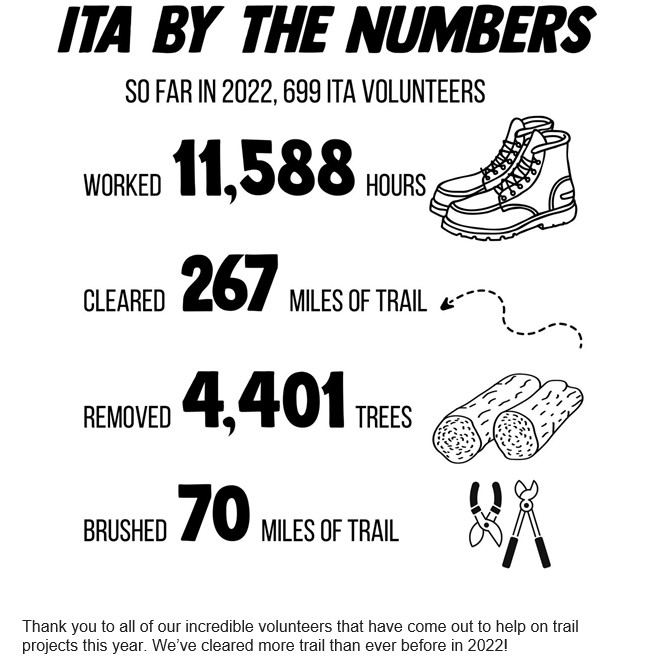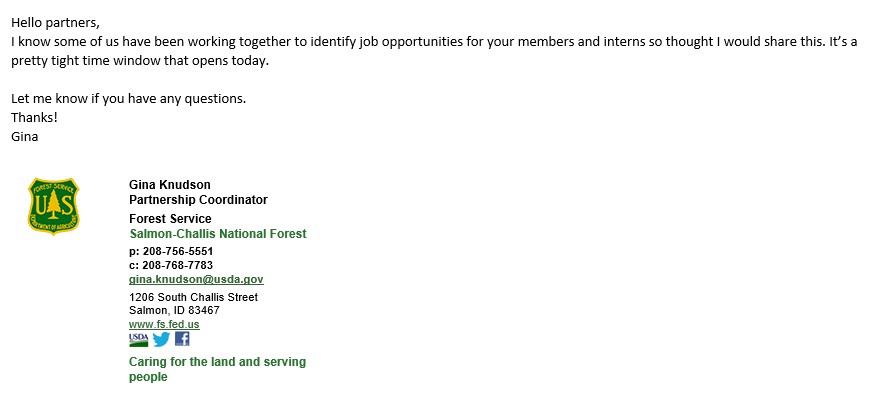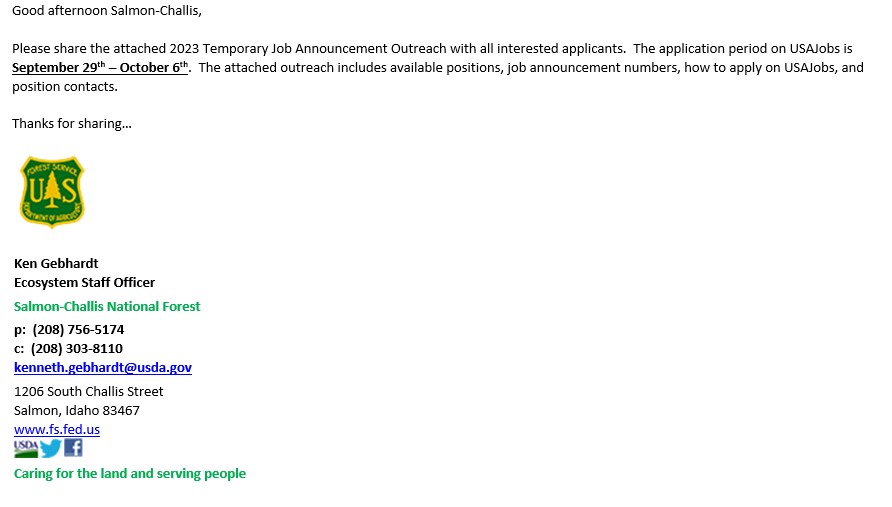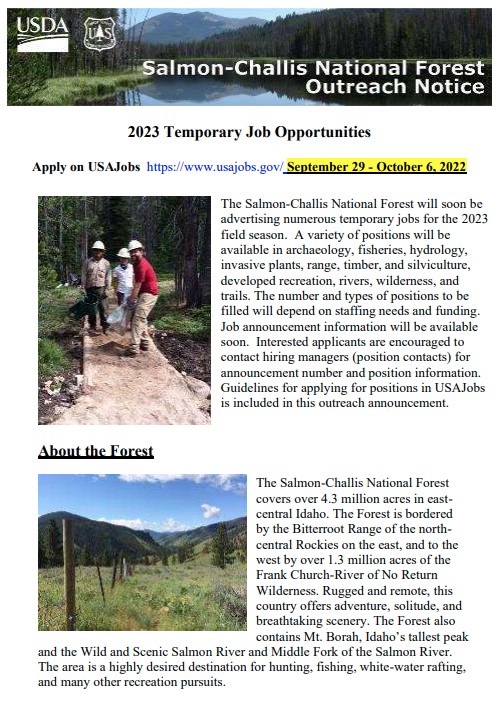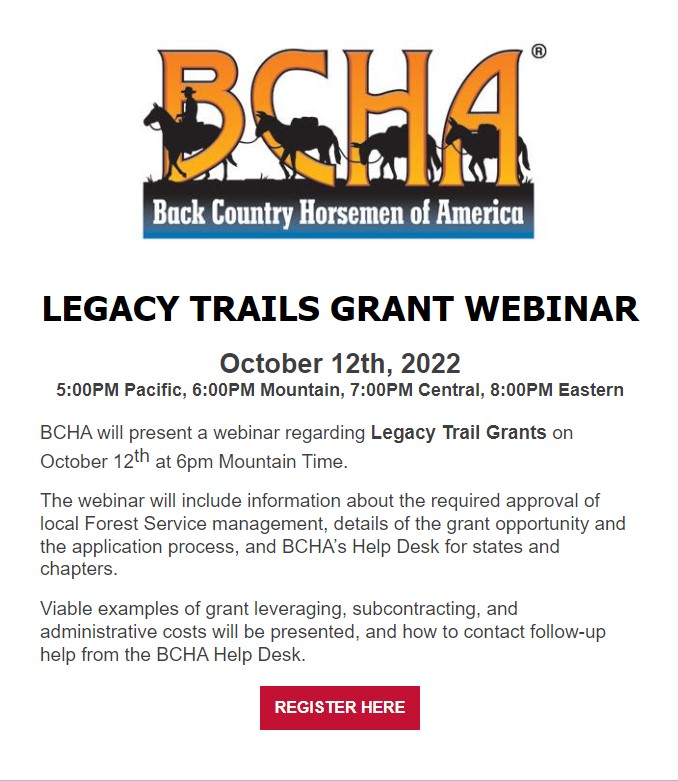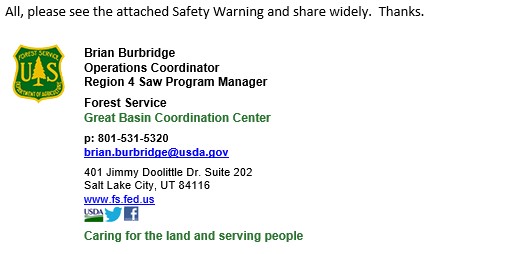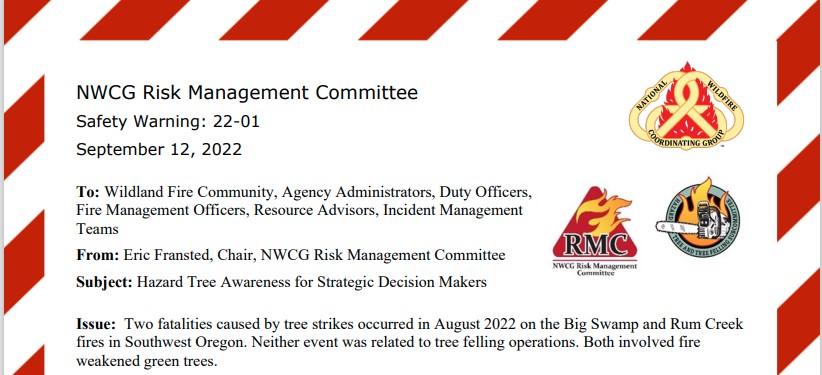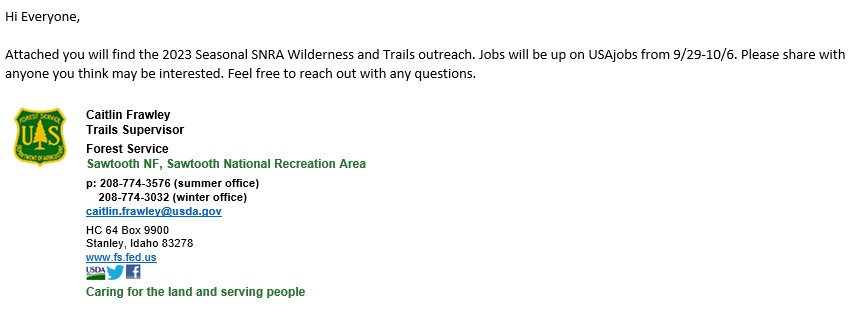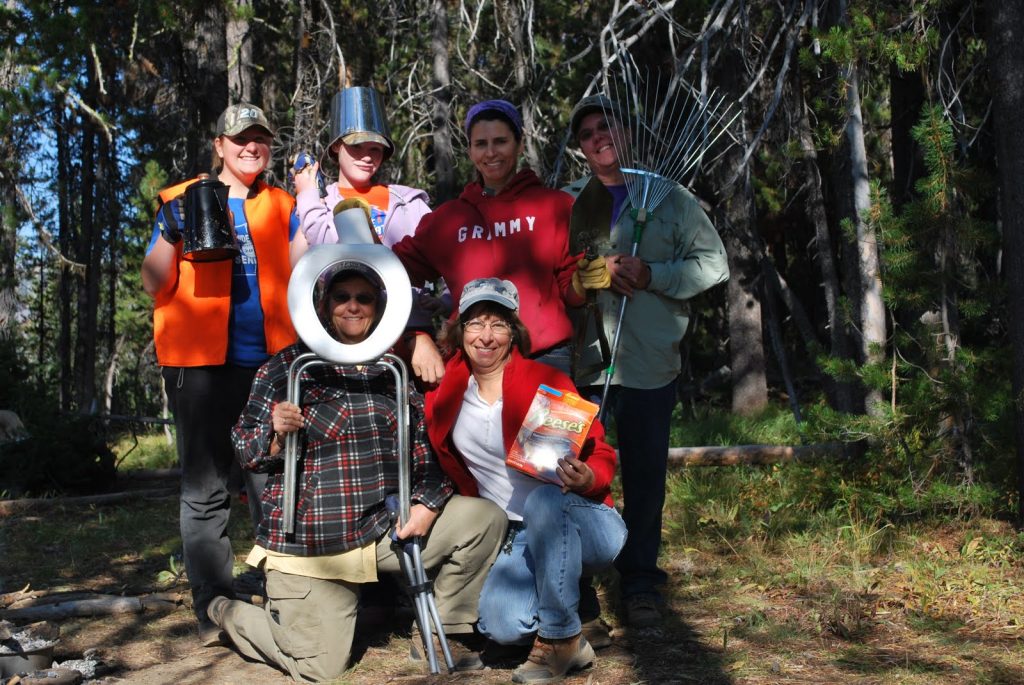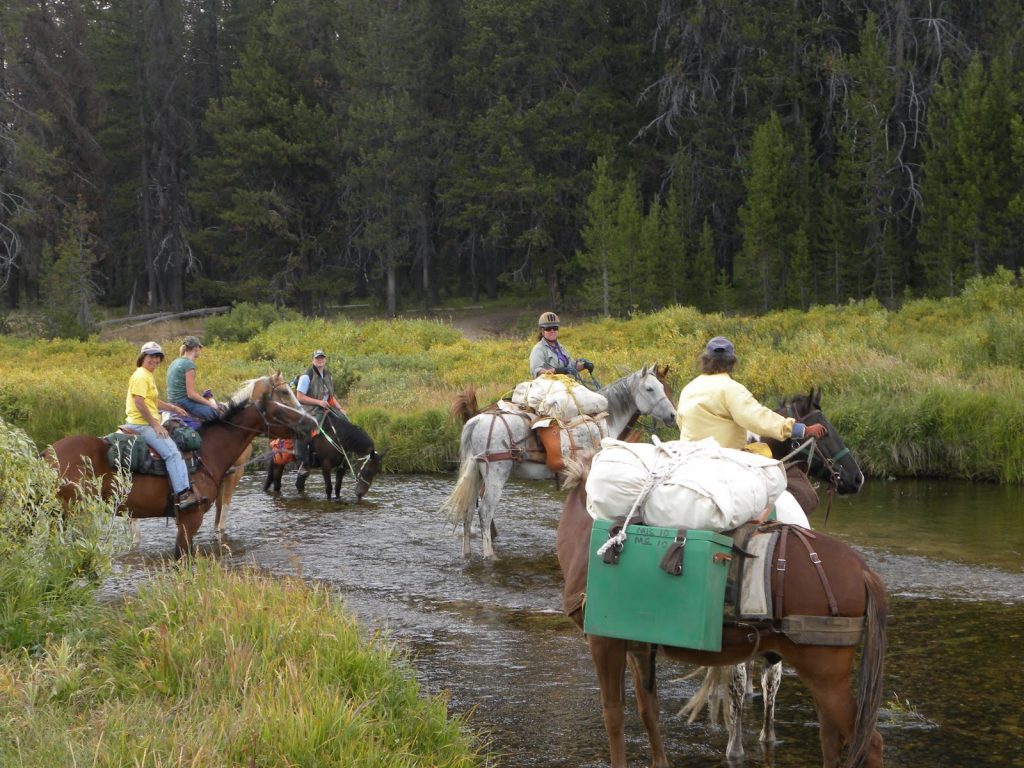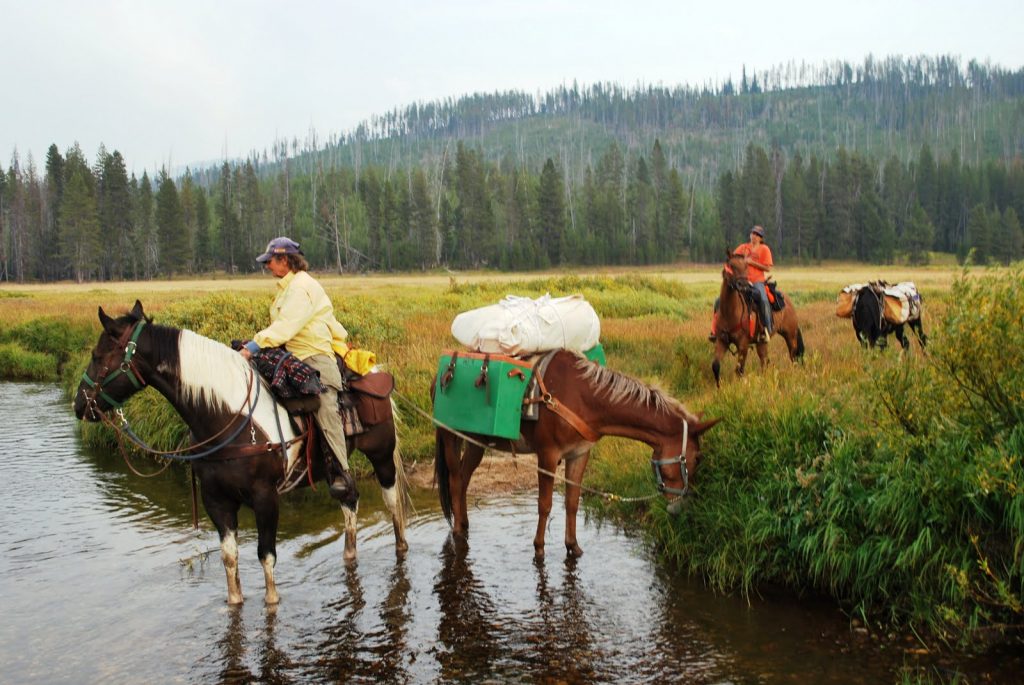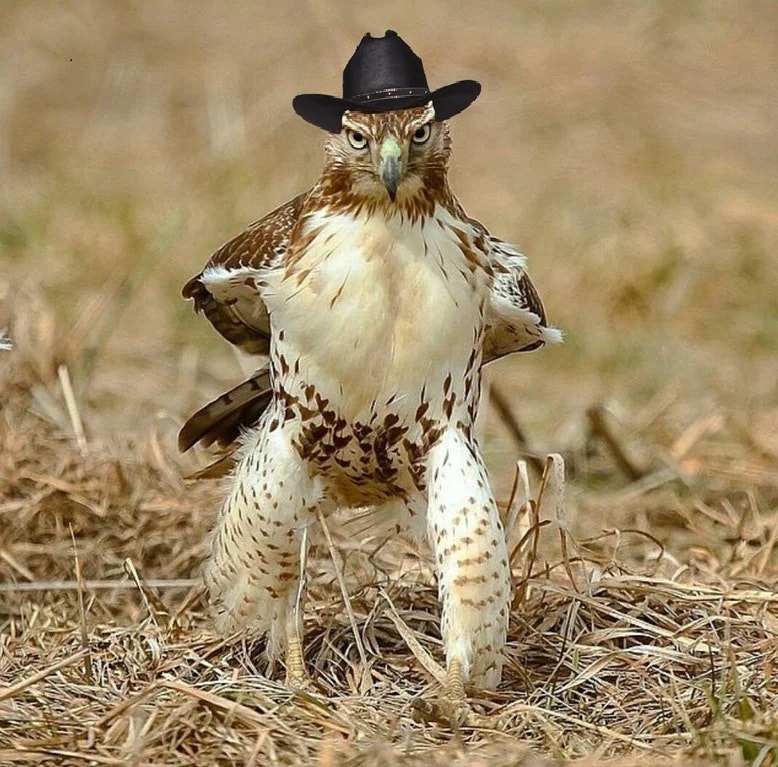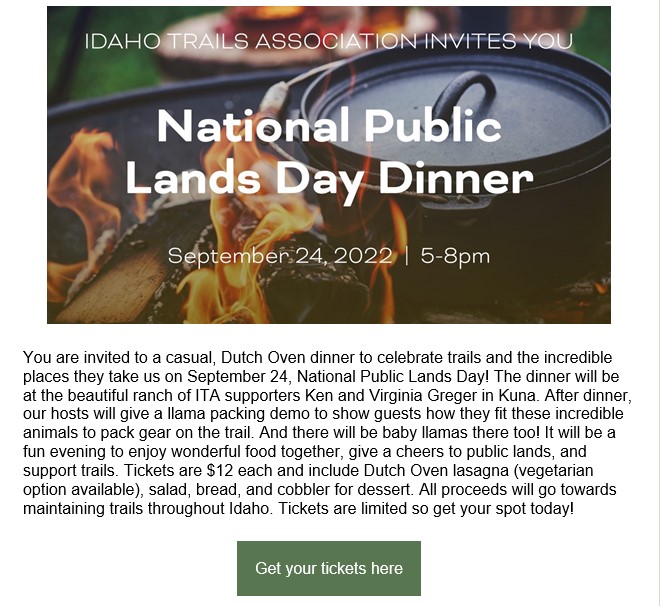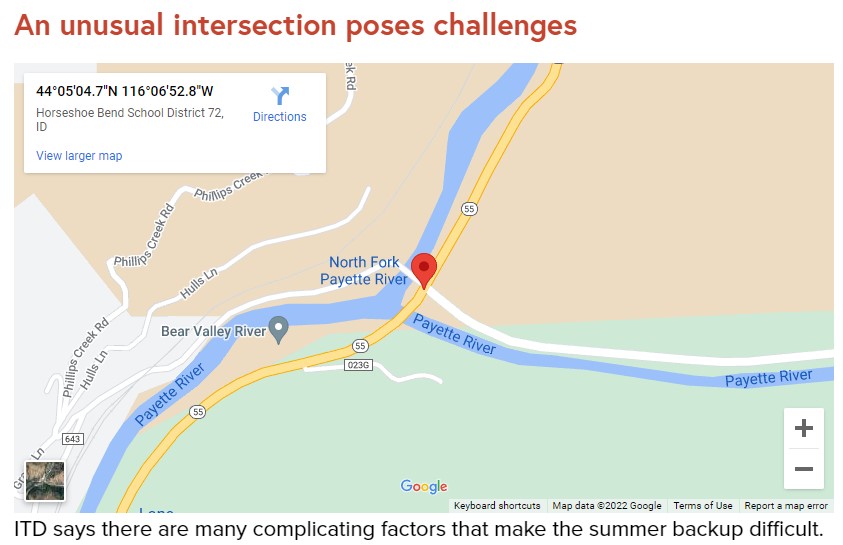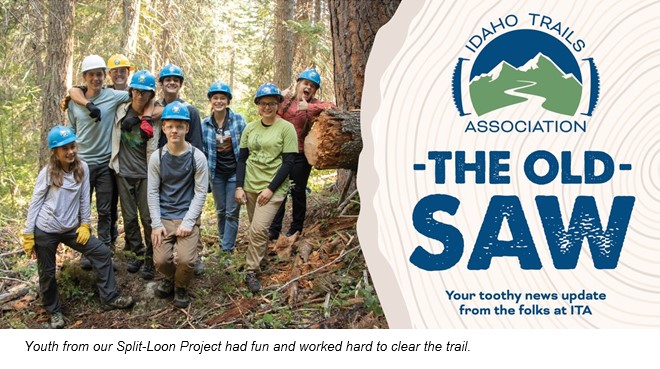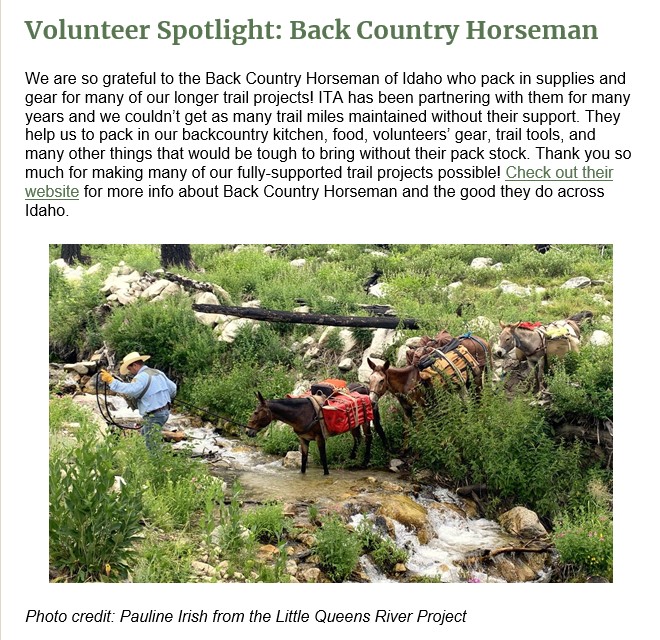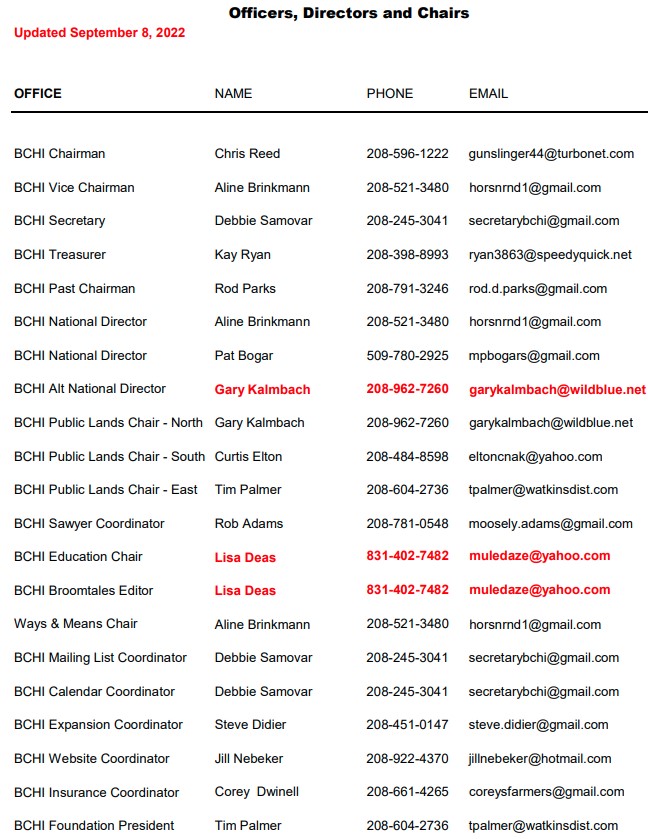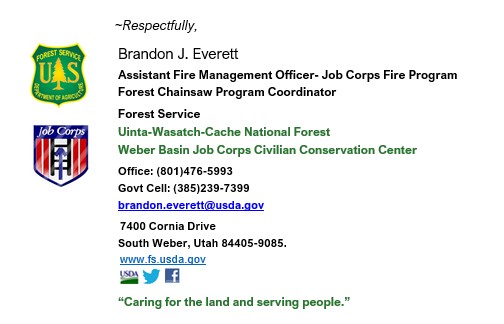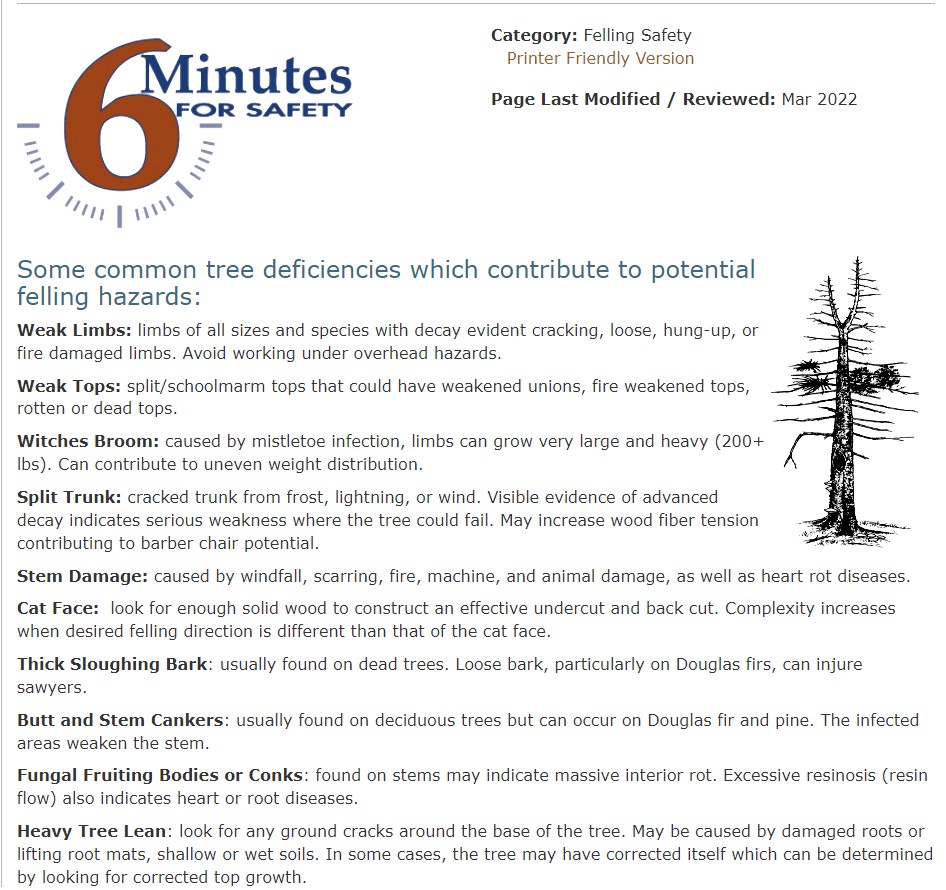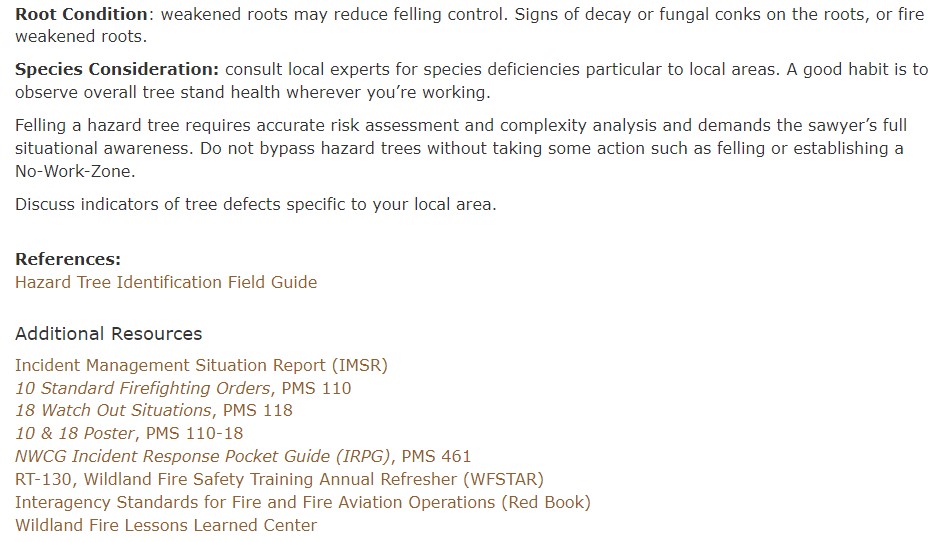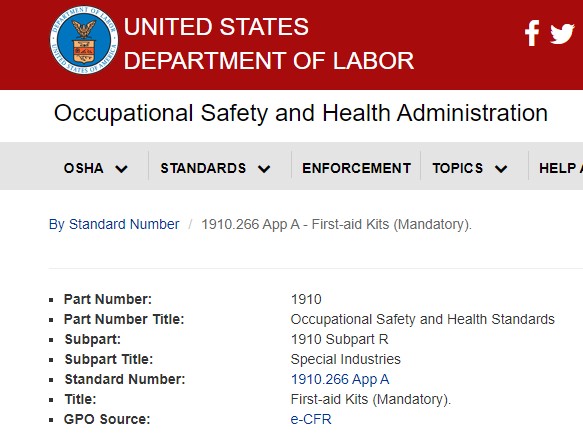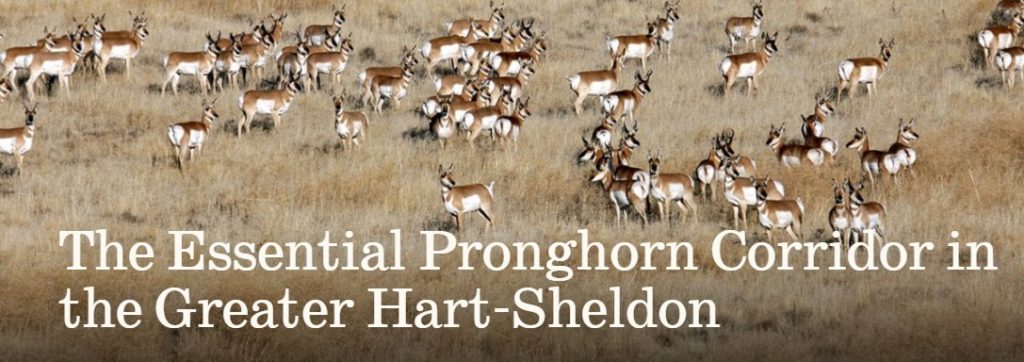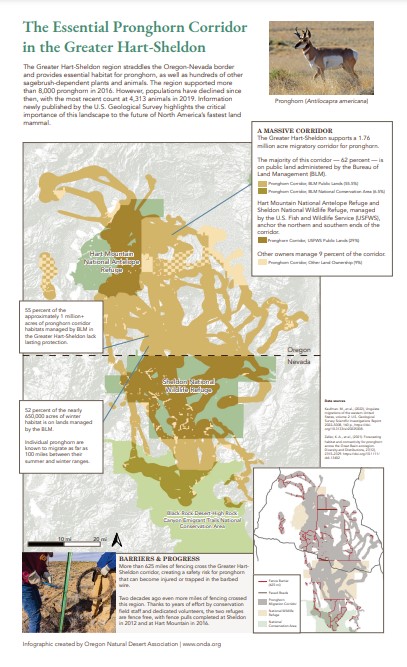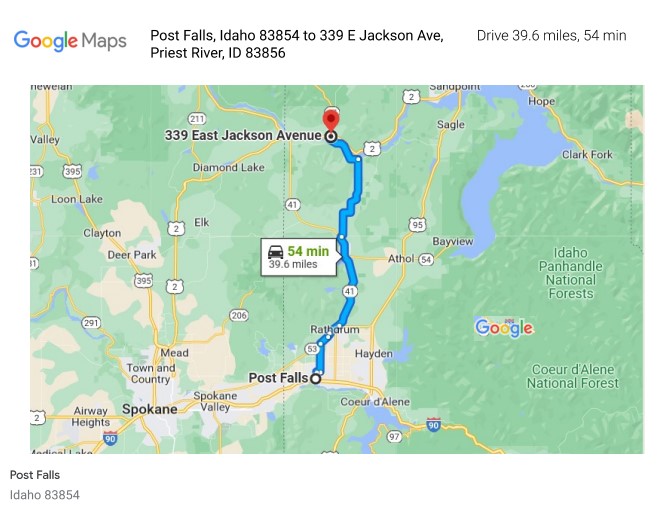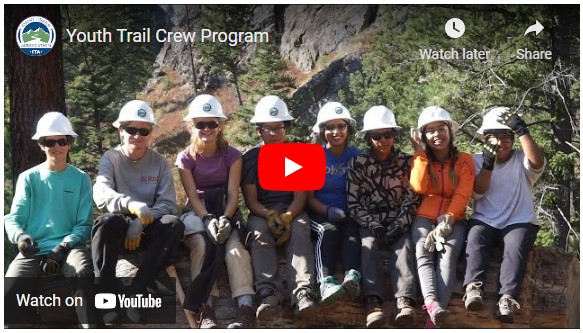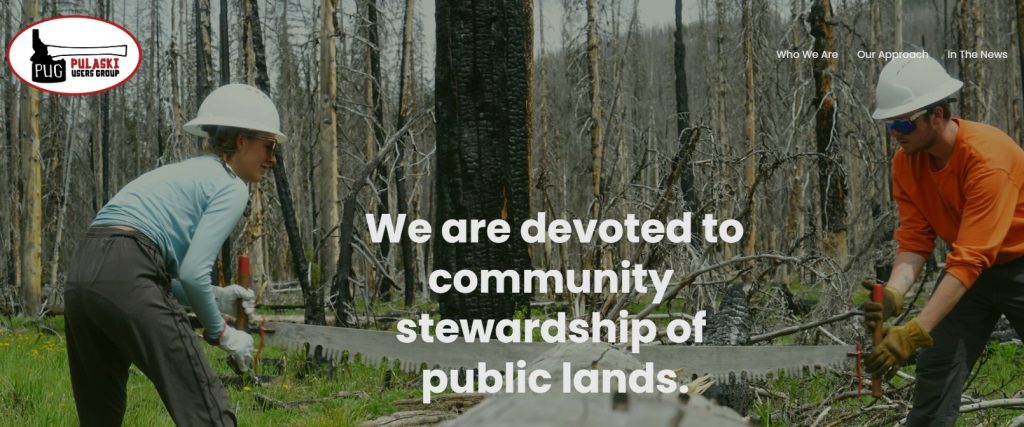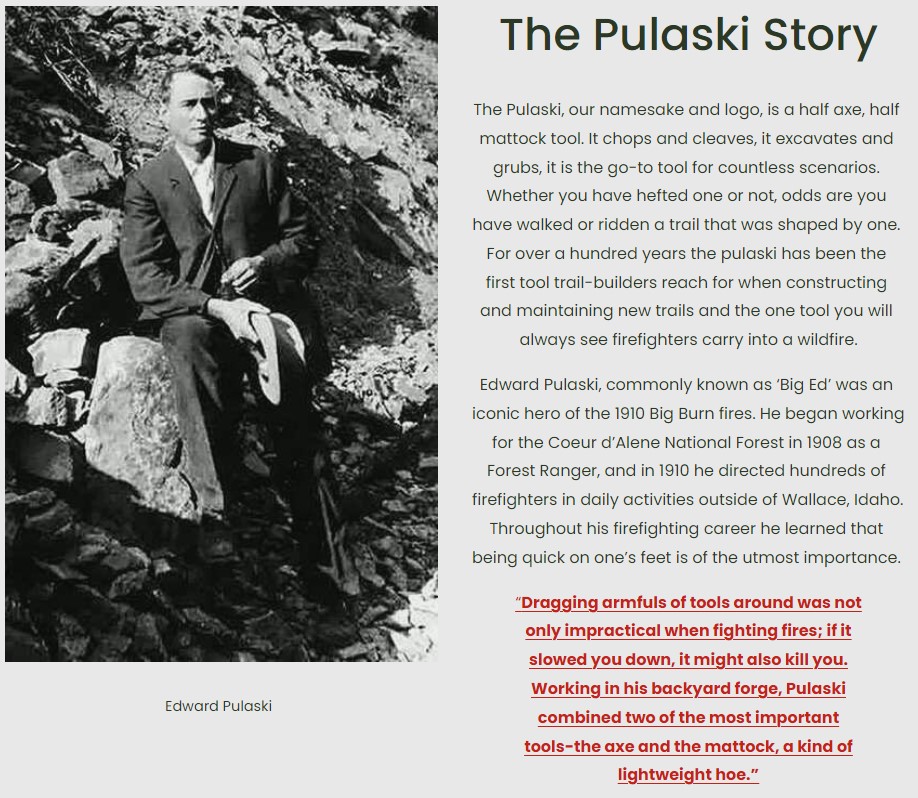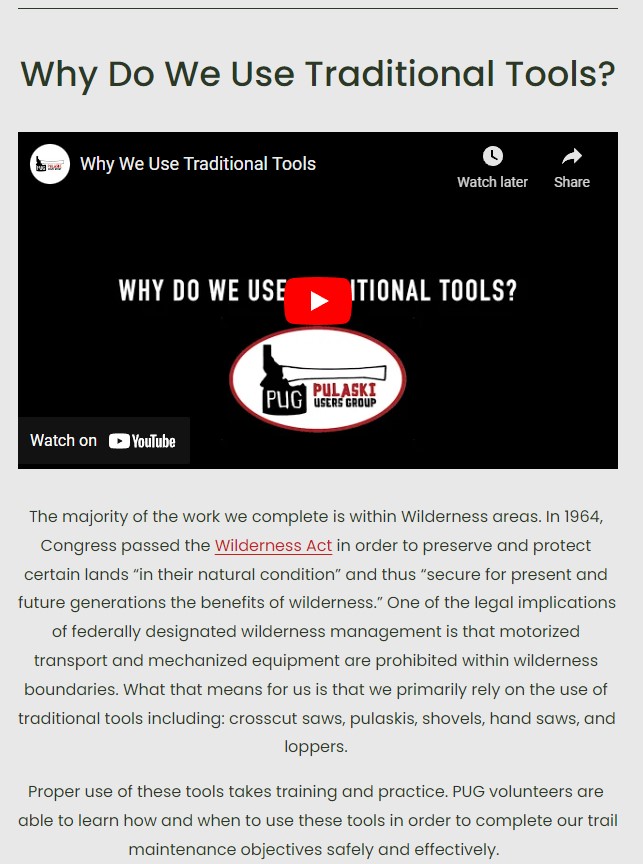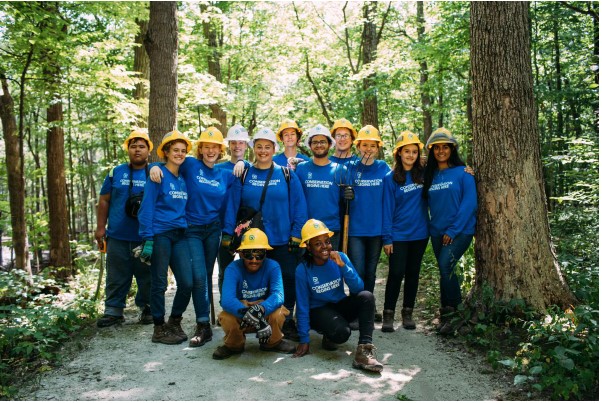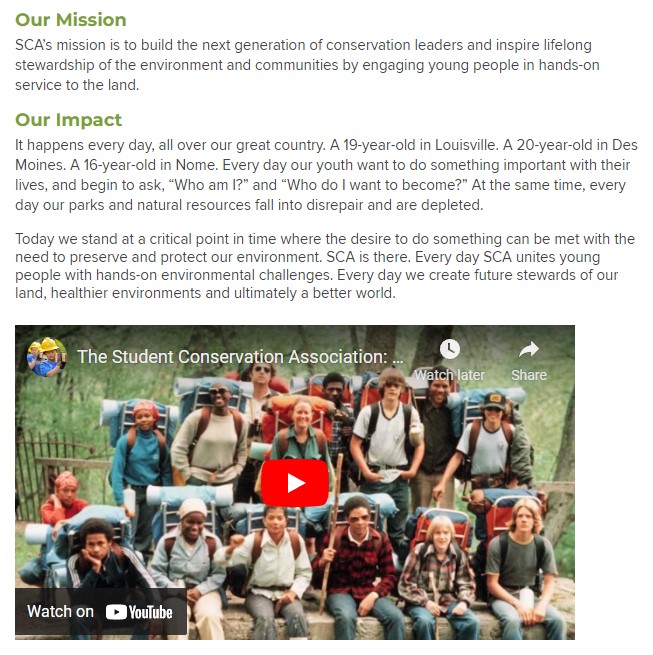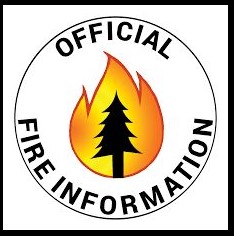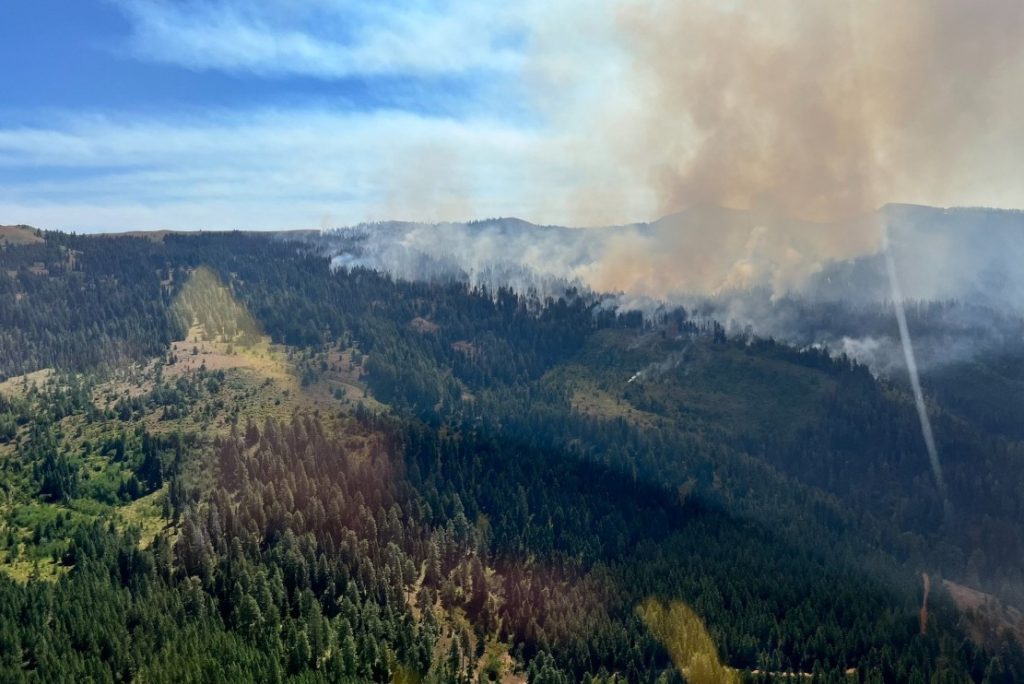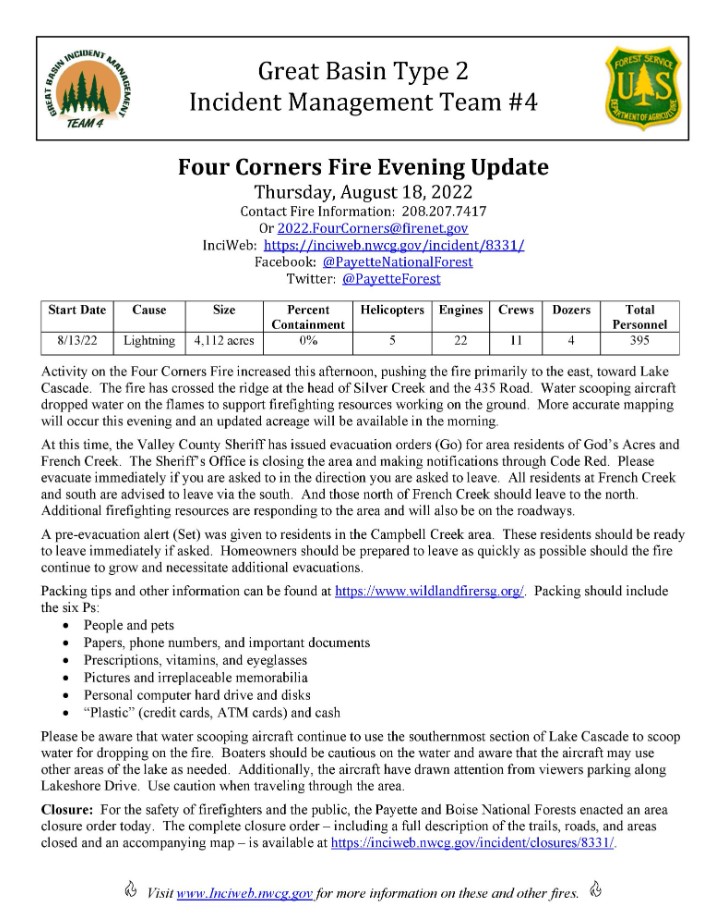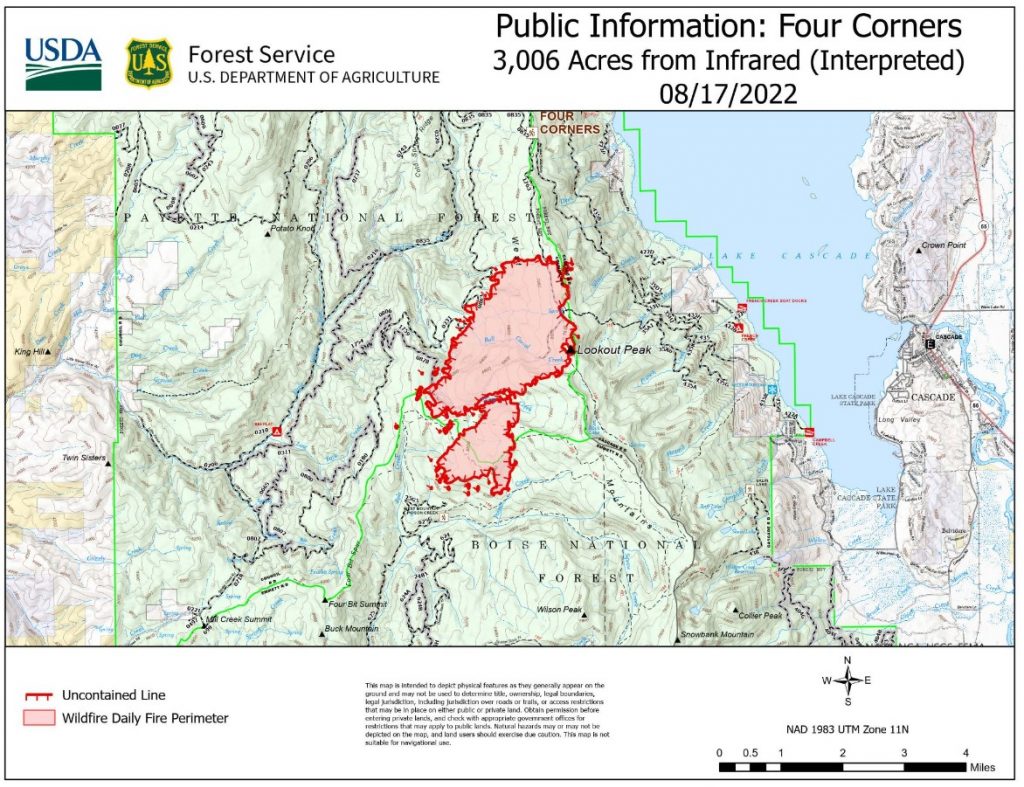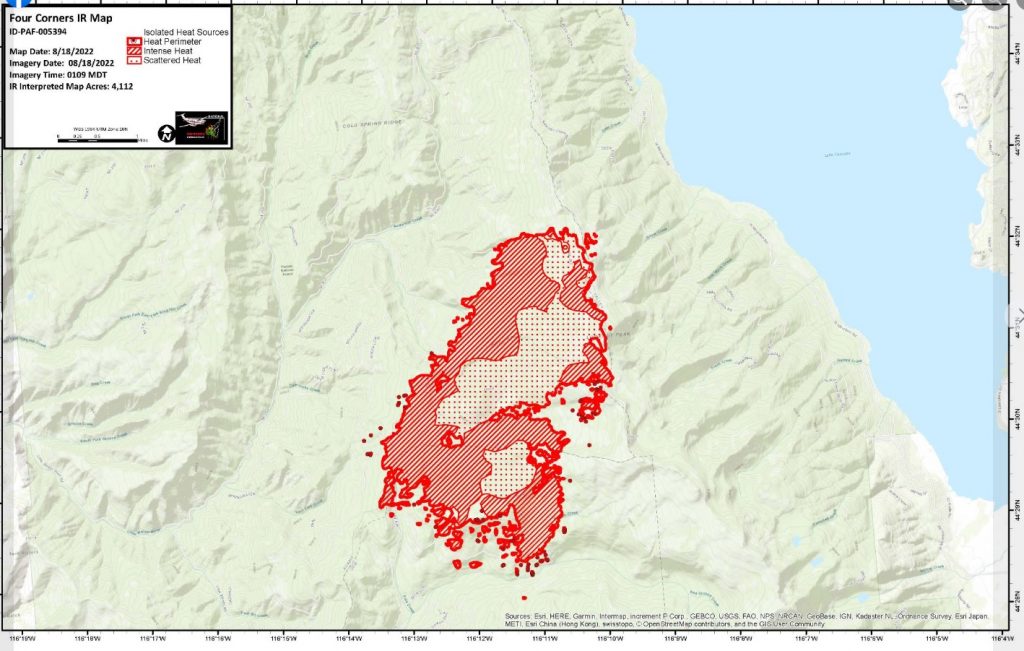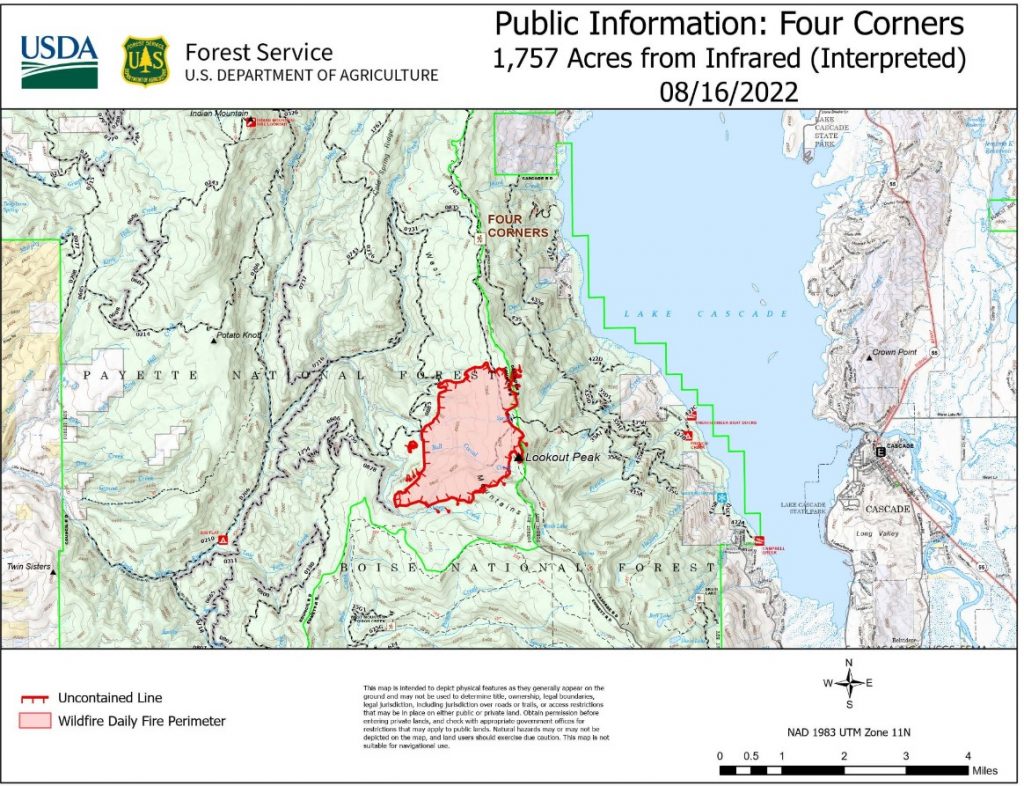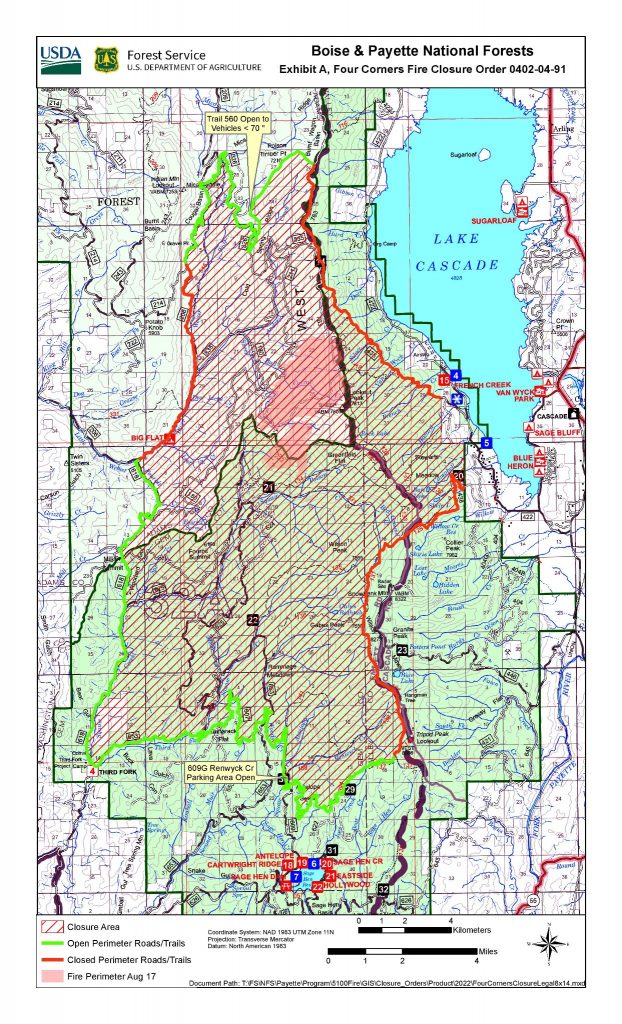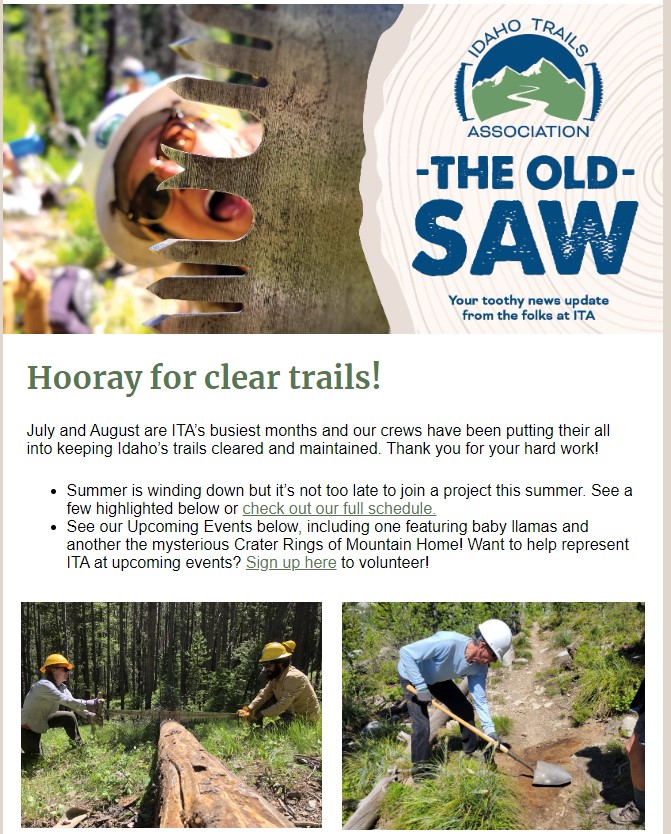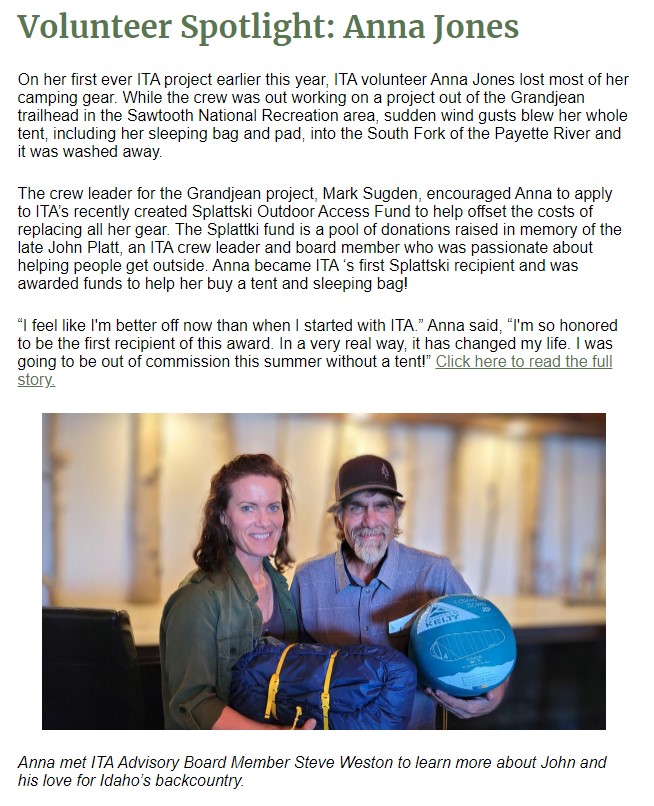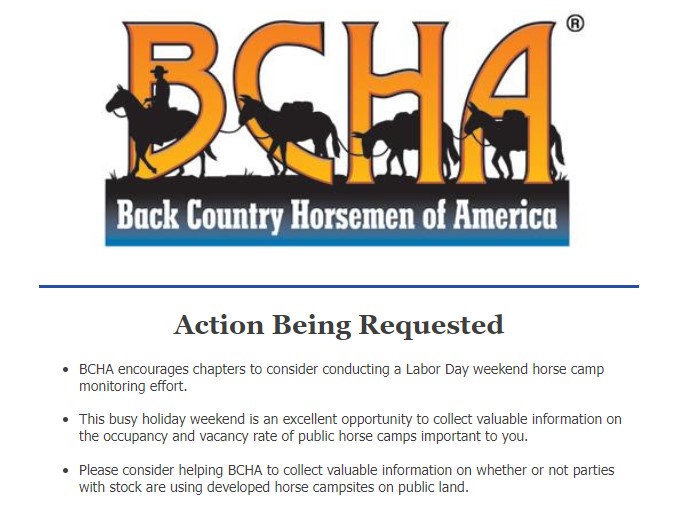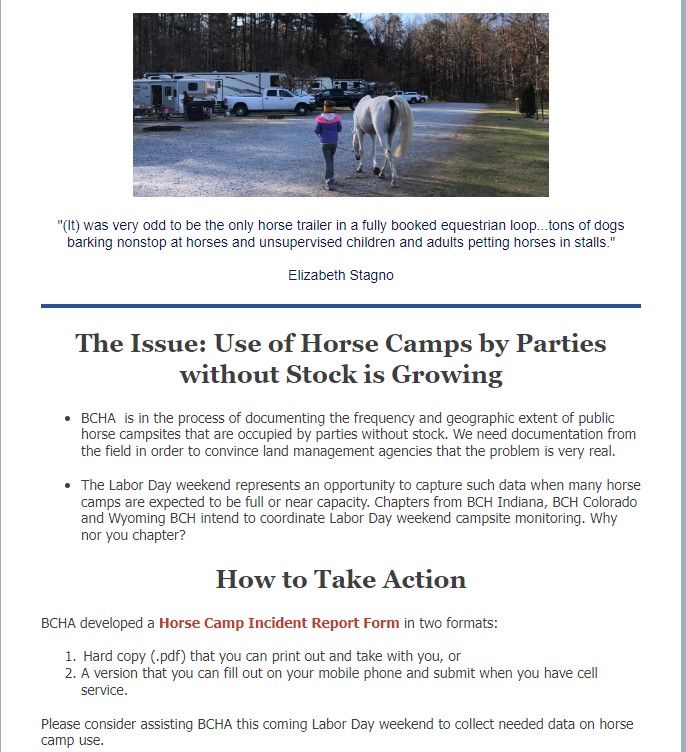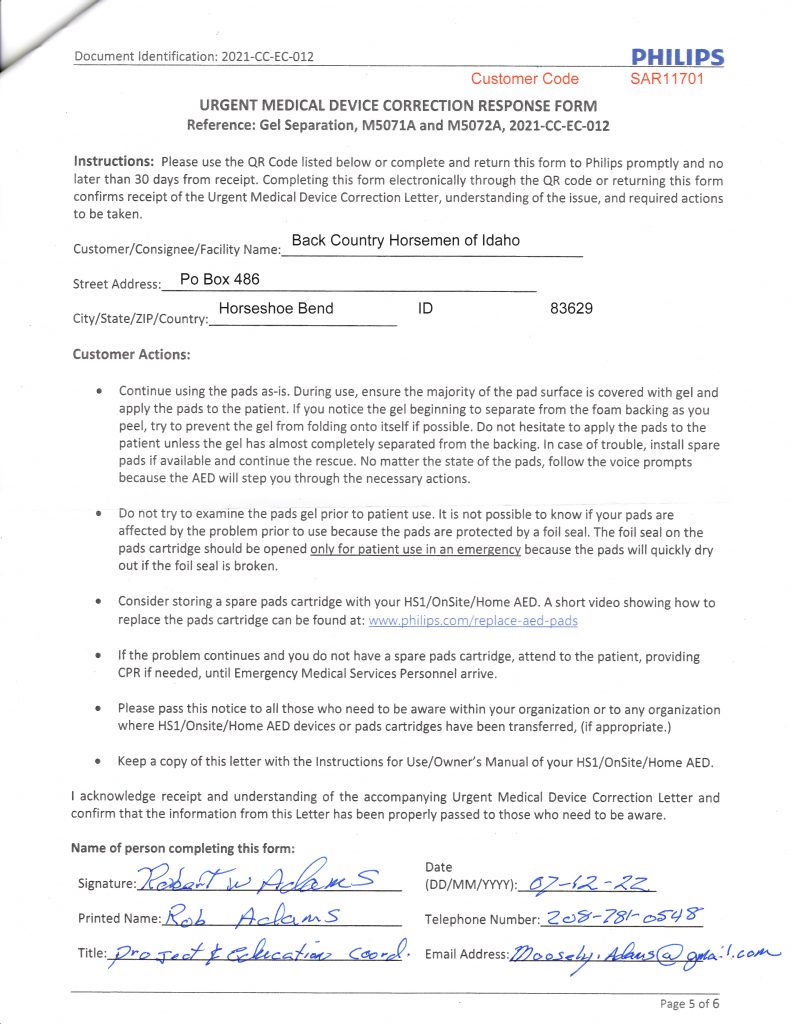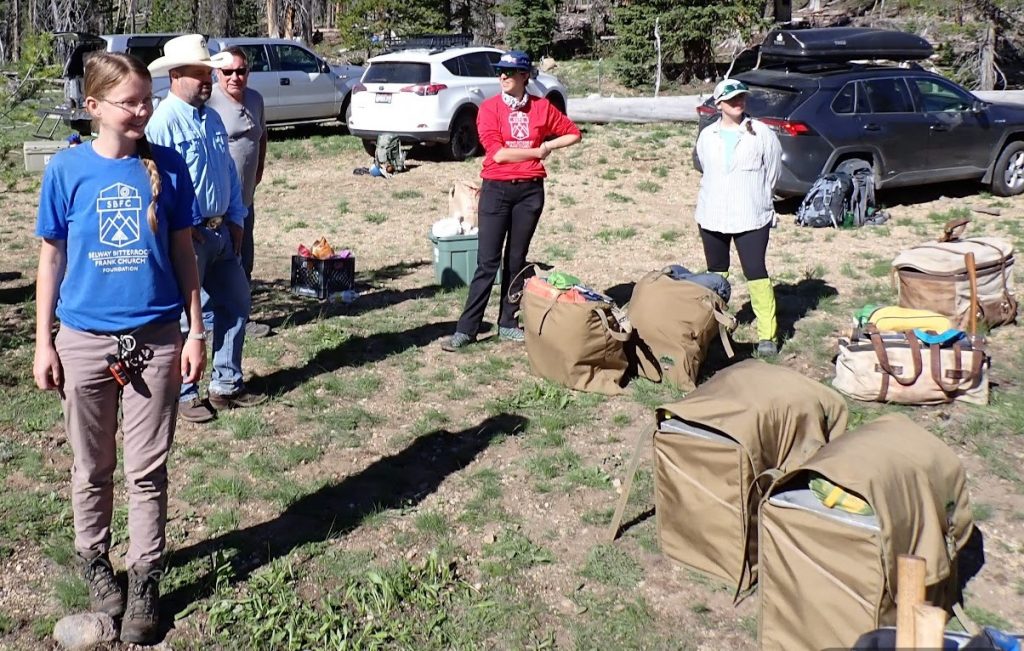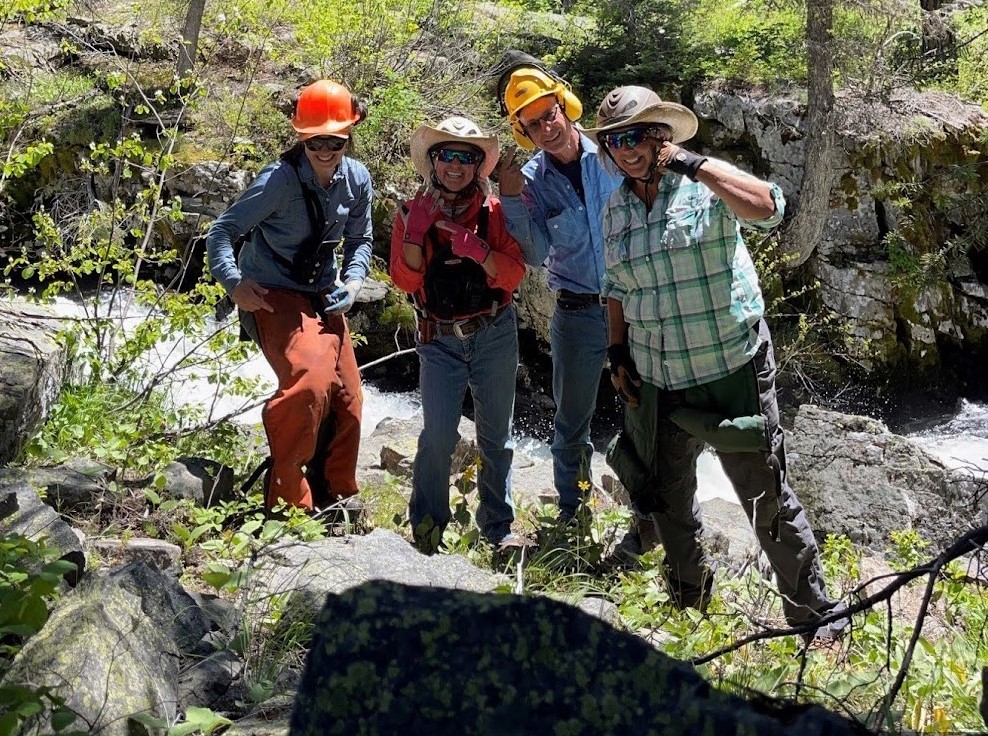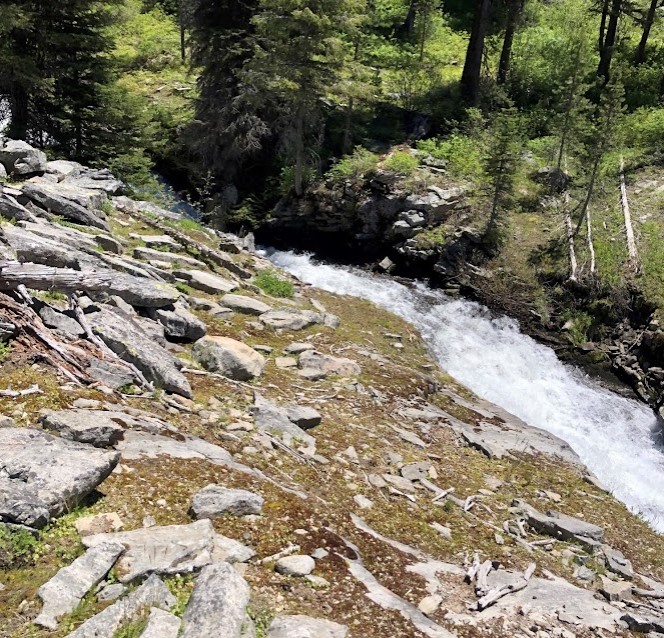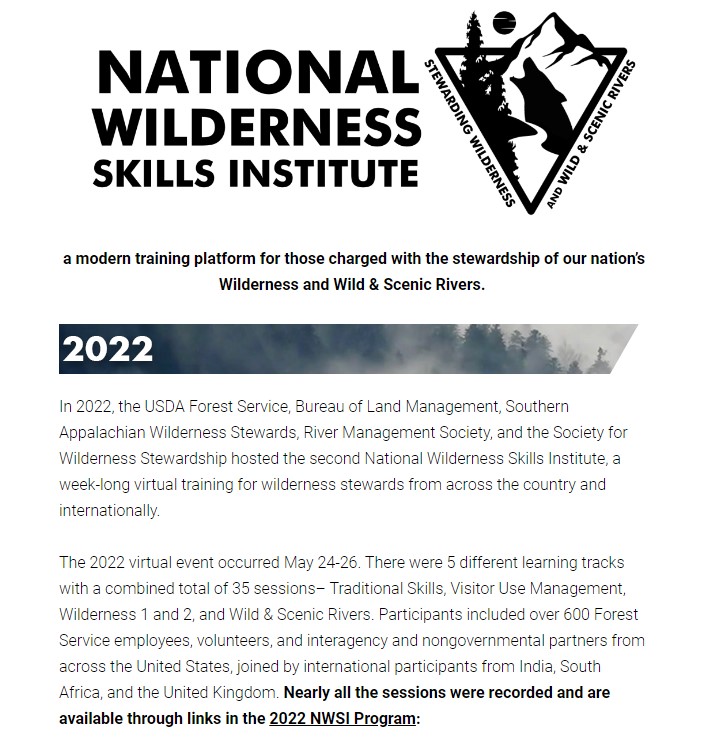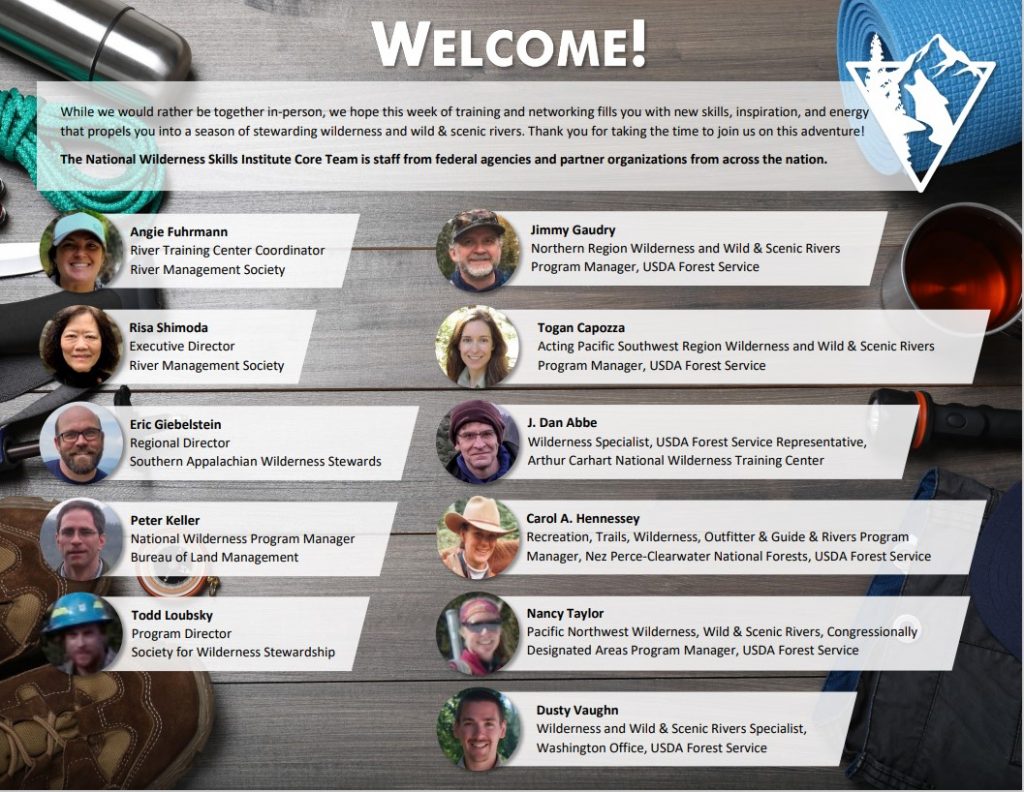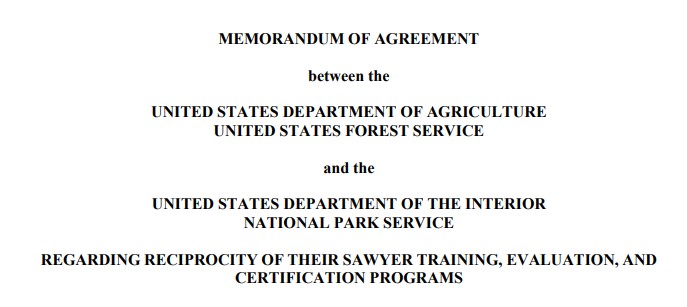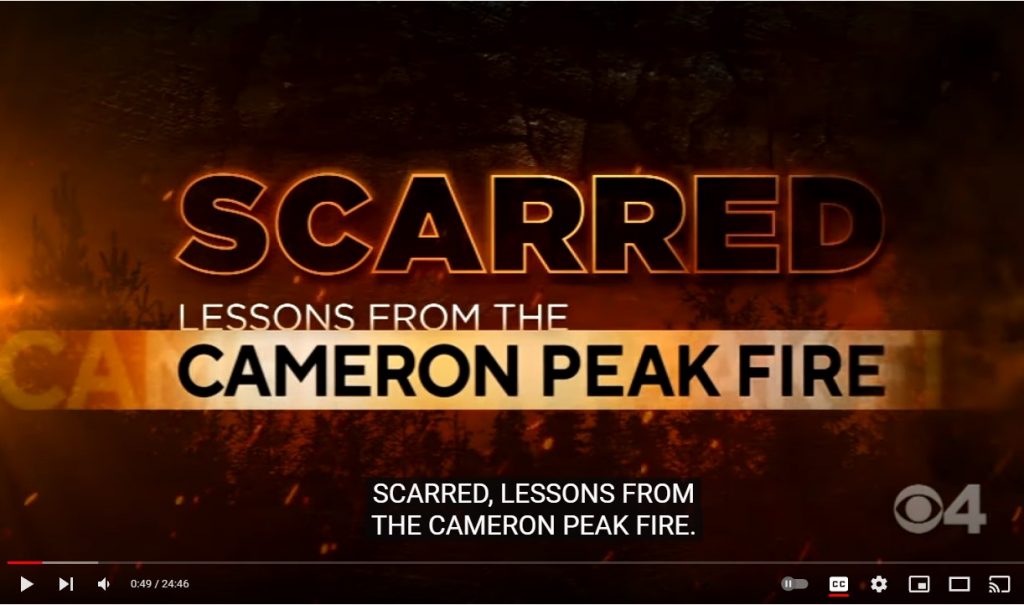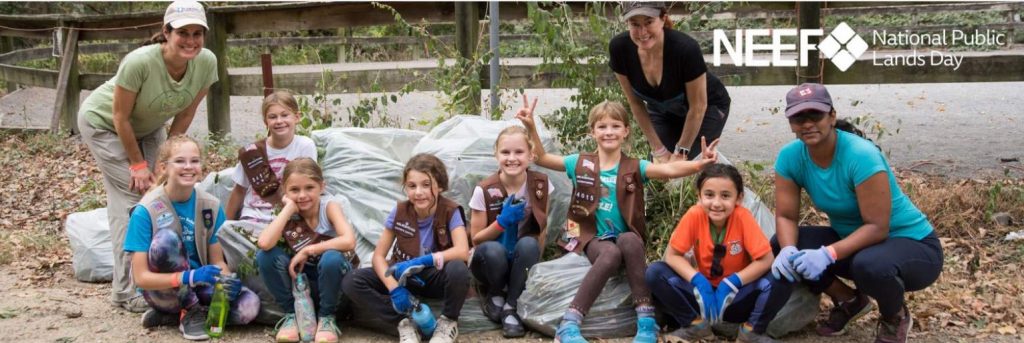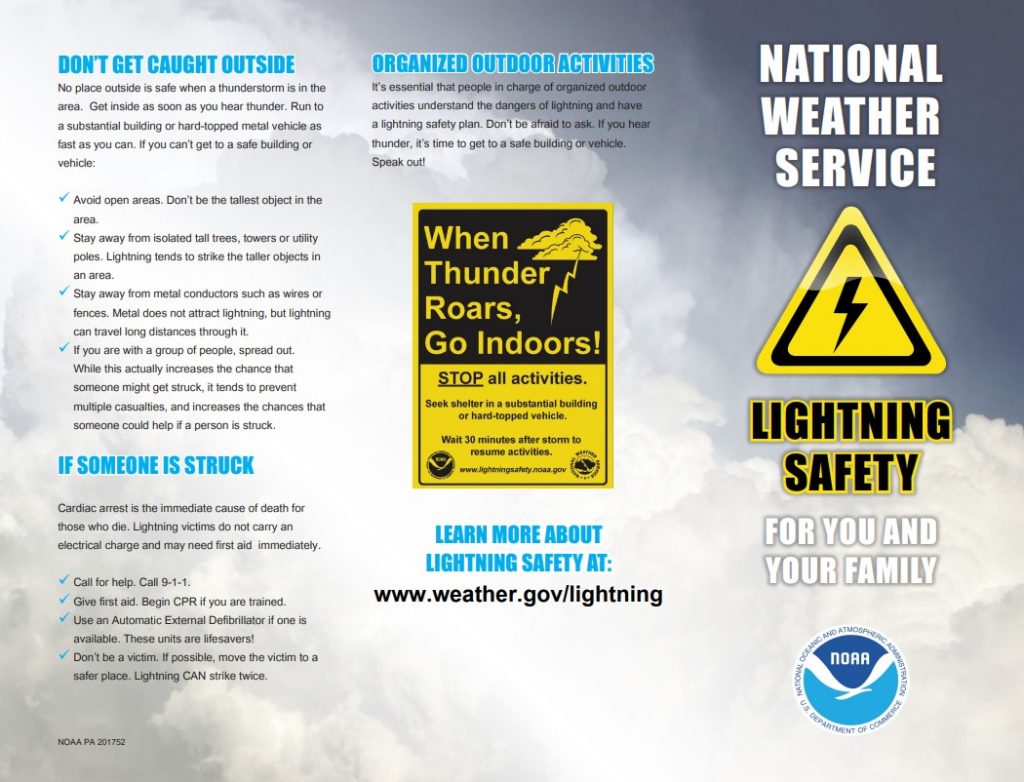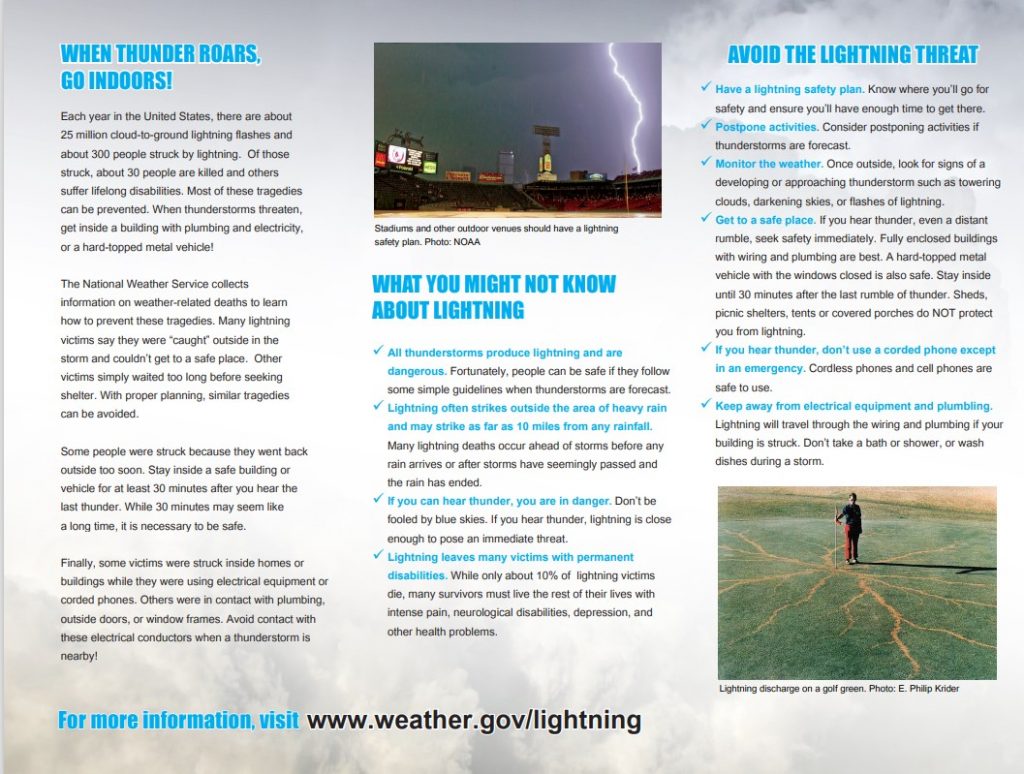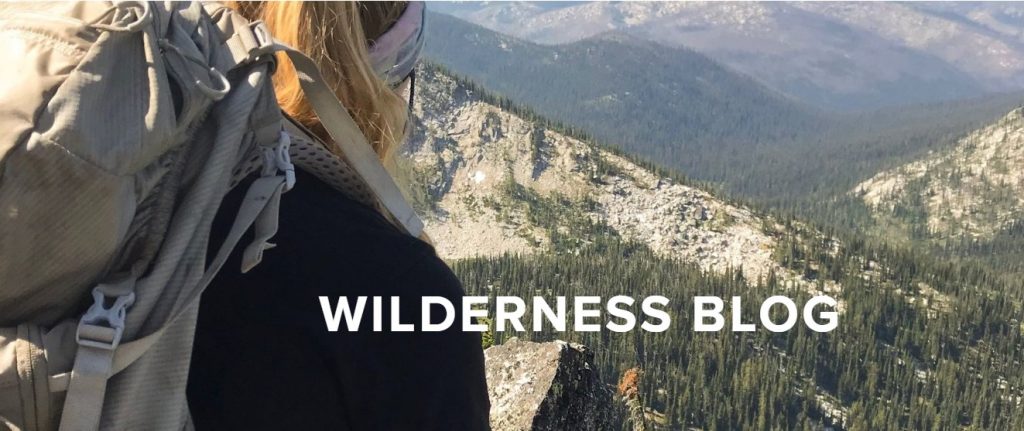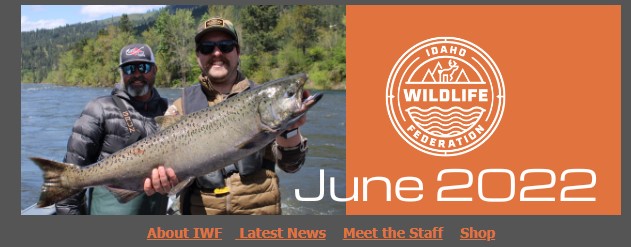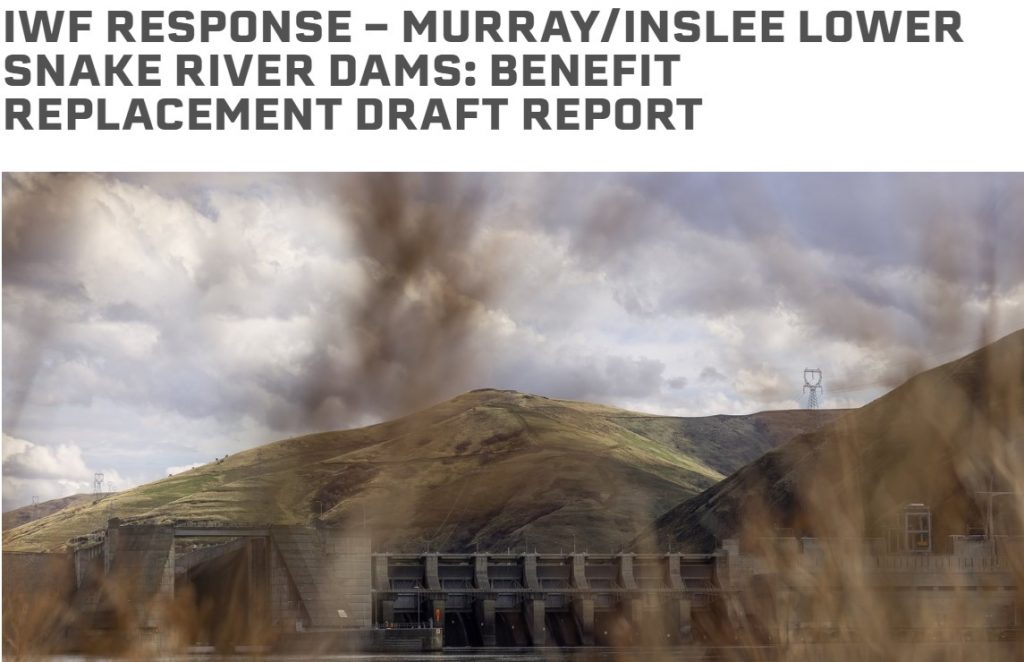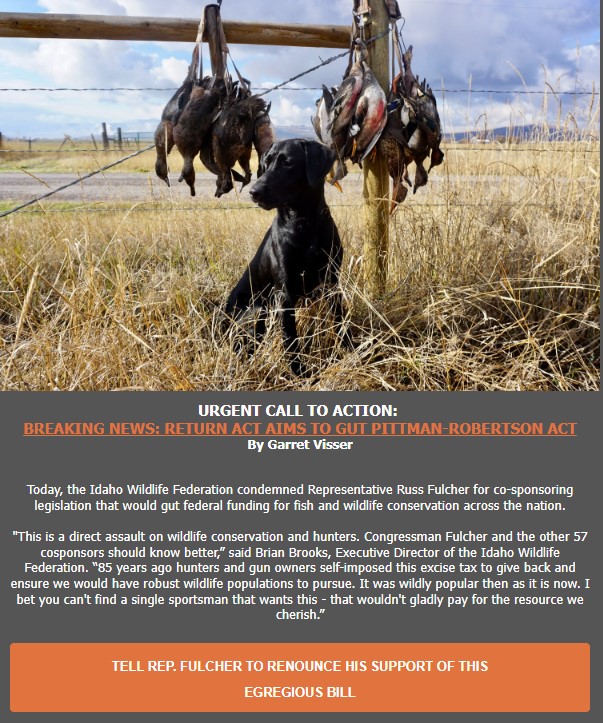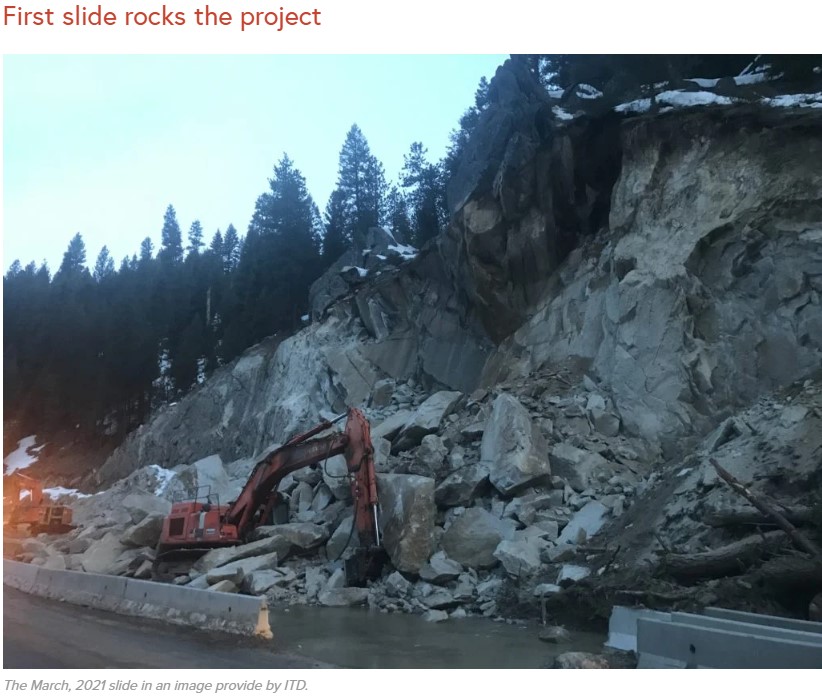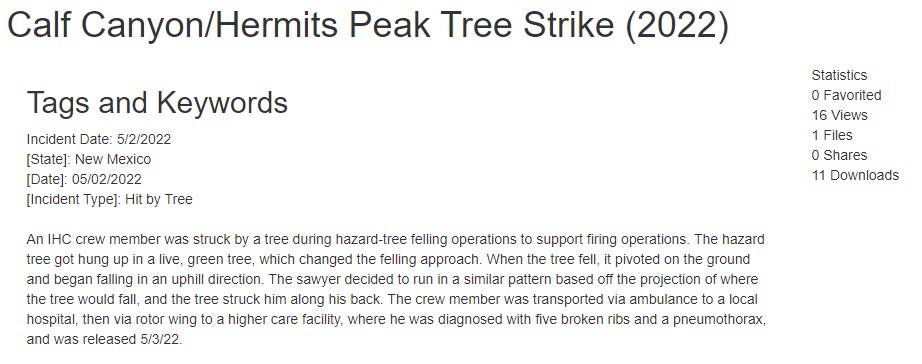This past weekend past member of our chapter John Bush passed away. He was in the Landmark area doing some trail clearing with Joe Williams. When they got back in camp, John mentioned to Joe that he was feeling very tired and needed to sit down. Joe said that John appeared to fall asleep and shortly after stopped breathing and died. John and Jackie were members of our chapter in the early 2000’s. This is Jackie’s contact information: Jackie Bush, 6700 Sage Canyon Way, Star, ID 83669
Star, Idaho – John Michael Bush, 69 years old, of Star, Idaho, passed away on October 15, 2022 in the mountains of the Idaho wilderness that he loved.
Mass of Christian burial will be Saturday, October 29, 2022, at 10:30 a.m. at St. Benedict Church in Atchison, Kansas, with Fr. Jeremy Heppler, OSB as celebrant. Interment will follow in Mt. Calvary Cemetery. Visitation with the family will be Friday, Oct. 28, from 6:00-7:30 p.m. at the Arensberg-Pruett Funeral Home.
John was born on December 23, 1952, in Atchison, Kansas, the son of Francis Miller Bush and Mary Elizabeth (Langan) Bush. He graduated from Maur Hill Prep and then the University of Kansas with his B.S. in Electrical Engineering. He remained an avid Jayhawk his entire life. Following graduation, he departed Kansas for Texas and began his long career in semiconductor design working with leading companies in the burgeoning electronics and computer industries. Though his path never led back for more than visits, John was always a steadfast Kansan and son of Atchison.
He and Mary Louise (Jackie) Bush were united in marriage on April 18, 1981, in Leon Springs, Texas.
John was endlessly curious and always testing or investigating new thoughts. Throughout life, he pursued serious interests in photography, horsemanship, outdoorsmanship, woodworking, gardening, skiing, and snorkeling. He had a flair for repairing machinery and electronics, as well as building and renovation, and never failed to share his talents with those around him. John was also a member and past president of the Backcountry Horsemen of Idaho where he led members on trips deep into the mountains and maintained trails used by all entering the backcountry.
He is preceded in death by his parents and siblings, James “Jim” Bush, Robert “Bob” Bush, Charles “Charlie” Bush, Thomas “Tom” Bush and Dorothy Bush.
John is survived by his wife, Mary Bush, of Star, ID; a daughter, Kathryn L. “Katie” and her spouse, Travis Field, of Seattle, WA; a son, James C. and his spouse, Caitlin Bush, of Olympia, WA; his grandson, Samuel M. Bush; four sisters, Elizabeth Adams, Virginia Lefler, Barbara Bush, Mary Lou Weatherford; and one brother, Richard Bush.
Pictures provided by Ellen Knapp

Every day, regular people like you lose their hard-earned money to online phishing scams.
Phishing is a type of online scam where criminals make fraudulent emails, phone calls, and texts that appear to come from a legitimate bank. The communication is designed to trick you into entering confidential information (like account numbers, passwords, PINs, or birthdays) into a fake website by clicking on a link, or to tell it to someone imitating your bank on the phone.
Don’t fall for fake. Use these tips from the American Bankers Association to learn how to spot shady texts, emails, and phone calls by knowing the things your bank would never ask.
- Slow down—think before you act. Acting too quickly when you receive phishing email, text messages, or phone calls can result in unintentionally giving scammers access to your bank account — and your money. Scammers want you to feel confused and rushed, which is always a red flag. Banks will never threaten you into responding or use high-pressure tactics.
- Never share personal information. Your bank will never ask for your PIN, password, SSN, or one-time login code in a text, email, or phone call. If you receive a message asking for personal information, it’s a scam.
- Avoid clicking suspicious links. If an email pressures you to click a link — whether it’s to verify your login credentials or make a payment, you can be sure it’s a scam. Banks never ask you to do that.
- Watch for attachments and typos. Your bank will never send attachments like a PDF in an unexpected email or text. Misspellings and poor grammar are also warning signs of a phishing scam.
- Be skeptical. In the same way defensive driving prevents car accidents, always treating incoming email as a potential risk will protect you from scams. Fraudulent emails can appear very convincing, using official language and logos, and even similar URLs.
- Hang up—even if it sounds legit. Whether it’s a scammer impersonating your bank or a real call, stay safe by ending unexpected calls and dialing the number on the back of your bank card instead.

Learn more at BanksNeverAskThat.com, follow #BanksNeverAskThat on social media for quick tips, or check this in-depth guide on how to spot phishing and what to do if you fall prey.
More Information on E-Bikes
To view a 2.5-minute YouTube video that includes eMTBs
and the various e-bike classes, click here.
For more information on current e-bike policies of the federal
land management agencies, see BCHA’s Winter 2021 newsletter.
Our Mission
Native Land Digital strives to create and foster conversations about the history of colonialism, Indigenous ways of knowing, and settler-Indigenous relations, through educational resources such as our map and Territory Acknowledgement Guide. We strive to go beyond old ways of talking about Indigenous people and to develop a platform where Indigenous communities can represent themselves and their histories on their own terms. In doing so, Native Land Digital creates spaces where non-Indigenous people can be invited and challenged to learn more about the lands they inhabit, the history of those lands, and how to actively be part of a better future going forward together.
The Importance of Land
Land is something sacred to all of us, whether we consciously appreciate it or not — it is the space upon which we play, live, eat, find love, and experience life. The land is ever-changing and ever-shifting, giving us — and other creatures and beings on the earth — an infinite number of gifts and lessons.
For Native Land Digital, what we are mapping is more than just a flat picture. The land itself is sacred, and it is not easy to draw lines that divide it up into chunks that delineate who “owns” different parts of land. In reality, we know that the land is not something to be exploited and “owned”, but something to be honoured and treasured. However, because of the complexities of history, the kind of mapping we undetake is an important exercise, insofar as it brings an awareness of the real lived history of Indigenous peoples and nations in a long era of colonialism.
We aim to improve the relationship of people, Indigenous and non-Indigenous, with the land around them and with the real history and sacredness of that land. This involves acknowledging and righting the wrongs of history, and also involves a personal journey through the importance of connecting with the earth, its creatures, and its teachings.
Thus, while we make a strong effort to teach about colonialism and to bring forth Indigenous narratives, we also strive to integrate what is sometimes called an “Indigenous way of knowing” when it comes to the importance and sacredness of land in our daily lives. We hope to inspire people to gain a better understanding of themselves, their ancestors, and the world they live in, so that we can all move forward into a better future.
Anna Daly writes: Idaho’s lakes and rivers provide many opportunities for anglers looking to hook something special.
Whether it’s a type of trout or salmon, all have their own unique colors and markings.
However, there is one fish swimming in Idaho’s high-mountain lakes whose beauty stands out from the rest: the Arctic Grayling.
Its sail-like fin that fans out across its back and its vibrant markings make this fish truly a striking catch.
The Arctic Grayling – which is a type of trout – is not native to the state and is a rare find in most places in Idaho. However, they are stocked in several backcountry mountain lakes.
They don’t get very big in Idaho’s cold lakes with the last record fish caught measuring 16.2 inches. According to Idaho Fish and Game, anything over 12 inches is considered a big Arctic Grayling.
To see when and where Idaho Fish and Game has stocked the Arctic Grayling, head to the Idaho Fishing Planner.
In 2020 BCHI assisted Fish & Game in stocking one lake on the western side of the Frank Church
BCHA will present a webinar regarding e-bike use on non-motorized trails on October 22nd at 10am Mountain Time.
The webinar will include information about:
- How electric motorized bicycles (e-bikes) represent a potential safety hazard to equestrians on trails, and
- How your chapter might prepare to respond to proposals by public land management agencies to add e-bike use on non-motorized trails.
We’ll offer hints on how to identify an e-bike in the field (hint: it’s not easy) and provide examples from BCHA’s success to date to challenge poorly conceived e-bike proposals on two national forests in the Southwestern U.S. Proposals to add e-bike use on non-motorized trails are accelerating across the country. BCHA chapters must be prepared to engage in constructive dialogue with agencies and other trail partners in order to defend trails important to horsemen.
The webinar is sponsored by BCHA’s Education Committee and Public Lands Committee.
Register in advance for this webinar. After registering, you will receive a confirmation email containing information about joining the meeting.
Join us for a Dutch Oven dinner to celebrate National Public Lands Day at the beautiful ranch of ITA supporters Ken and Virginia Greger. Tickets are $12 each and include Dutch Oven lasagna (vegetarian option available), salad, bread, and dessert. After dinner, our host and cook, Ken Greger, will give a llama packing demonstration with his herd. The best part? There will be baby llamas! Come celebrate our public lands and give back to your trails. The number of tickets are limited so get your spot today! Ticket sales will close Friday, September 23.
Doors open 5:00pm, dinner will be served at 5:30pm.
BYOB: Lemonade and water will be available but feel free to bring your own alcoholic drinks if you’d like.
Location: Ken and Virginia Greger’s Ranch, 2011 S. Luker Rd, Kuna, ID 83634
https://edits.nationalmap.gov/apps/gaz-domestic/public/all-official-sq-names
The U.S. Department of Interior’s Board on Geographic Names has voted to approve replacement names for 650 places across the West, including Idaho, that included the slur “sq—.”
The board voted Thursday to approve the replacement names, including 71 places in Idaho, as part of an effort to remove the term from federal use, according to a press release issued by the U.S. Department of Interior. Department officials said the term is used as an offensive ethnic, racist and sexist slur for Indigenous women.
“I feel a deep obligation to use my platform to ensure that our public lands and waters are accessible and welcoming. That starts with removing racist and derogatory names that have graced federal locations for far too long,” Secretary of Interior Deb Haaland said in a written statement. “I am grateful to the members of the Derogatory Geographic Names Task Force and the Board on Geographic Names for their efforts to prioritize this important work. Together, we are showing why representation matters and charting a path for an inclusive America.”
The vote came after the Derogatory Geographic Names Task Force spent months reviewing public comment and recommendations from 70 tribal governments that participated in the process, U.S. Department of Interior officials said. Overall, the task force received more than 1,000 recommendations for name changes, including several different recommendations for some of the same places or features.
The new names are in place effective immediately for federal use, officials said.
In Idaho, the changes included renaming 14 different streams named “Sq— Creek” and giving them new names that include Priest Stream, Chief Eagle Eye Creek, Pia Soko Naokwaide, Yeva Agai Naokwaide and Newe Waippe Naokwaide.
Other examples include replacing the name “Sq— Mountain” for two different mountains, which are now called Willow Spring Mountain and Spring Valley Mountain. Four other mountains named “Sq— Peak” were also renamed Santa Rita Peak, Wheatfield Mountain, Sierra Ancha Peak, and Porcupine Mountain.
The complete list of places with replacement names is available on the U.S. Geographic Survey website.
Margaret Carmel – BoiseDev Sr. Reporter
Date: September 13, 2022
Picture it: You’ve just spent a relaxing, but tiring weekend hiking in Garden Valley and all you can think about is hitting the hay at home in the Treasure Valley.
But, as you come down Banks-Lowman Road you slow to a stop behind a sea of brake lights. Nothing moves for minutes at a time, until you can crawl ahead a car’s length toward the intersection with Highway 55.
This is the scene at the busy intersection many Sunday afternoons in the summer months as vacationers return to the Treasure Valley from getaways in McCall and Cascadee. The seemingly endless stream of southbound traffic creates long backups on Banks-Lowman Road as travelers are forced to wait for few and far between openings between cars to turn onto the highway and head south.
The Idaho Transportation Department has a study underway of the intersection to evaluate its options to address the backups, which should be completed later this year. The study will examine “viable options” to address the seasonable backups in the area and propose early designs for how to improve the area.
“It’s a major step in outlining the cost of a project and its prioritization in our long-range plan,” ITD spokesperson Jillian Garrigues wrote in an email to BoiseDev.
Flaggers work the intersection on holiday weekends to address traffic problems at the cost of $3,500 per day. In 2022 there were flaggers on the intersection for six days at a cost of $28,000.
But, the study, which was paid for with a grant from the Federal Highway Administration, doesn’t mean the project will get done. ITD would still need more funds to finish the final design, acquire the land to build the project, and complete the construction.
One of the big obstacles to working on the intersection is the one-lane bridge on the west side of the intersection that leads to a boat ramp on the river. Because of the one lane of travel on the bridge, it means cars turning in and out of the bridge need extra time to move in and out, slowing traffic.
A 2018 blog post authored by former ITD spokesperson Jake Melder said a stoplight would also slow traffic down, but in a different way than the current situation. When asked about the intersection, Garrigues pointed BoiseDev to Melder’s blog post as an answer to our inquiries.
“Another concern is that a signal will force the currently free-flowing traffic on ID-55 to stop,” Melder said. “This creates a queue. As that queue backs up, major safety concerns arise. Imagine a driver coming down the mountain going 55mph, turning a corner and suddenly coming upon break lights. A signal adds new safety and mobility concerns, with every bit as much risk of serious injury as the existing condition, and possibly more overall delay for travelers.”
A roundabout would also help ease the congestion at the intersection on holiday weekends, but they require a large area to operate in. This intersection is currently bounded by rivers and steep mountainsides, which ITD says leaves it little room to construct a roundabout. Roundabouts also require two lanes of travel in and out to allow for proper and safe passing, but the one-lane bridge complicates this because it wouldn’t have a way for two lanes of traffic to turn right onto the bridge. Boise County, not ITD, owns the bridge.
“Things are very tight with three of the quadrants bordered by rivers and the last hugging a mountainside,” Melder wrote in his blog post. “A roundabout would either require a massive bridge structure or significant carving out of the mountainside.”
 The third option under study would add a third lane for southbound traffic open for left-turning traffic from Banks-Lowman. Then, once someone turns onto the highway they could use that third lane to gain speed and merge onto Highway 55.
The third option under study would add a third lane for southbound traffic open for left-turning traffic from Banks-Lowman. Then, once someone turns onto the highway they could use that third lane to gain speed and merge onto Highway 55.
This would require the construction of a new, wider bridge on the southern end of the intersection to make room for the third lane. In order to fit a wider bridge into the area, ITD would have to cut into the mountainside both north and south of Banks-Lowman to add space for the lane.
“The silver lining for this option is the age of the bridge on ID-55,” Melder wrote. “Though it is safe today, it will have to be replaced in the near future due to its age and condition. Replacing it with a wider bridge becomes much more cost-effective at that time. Currently, this bridge is not scheduled for replacement in our 7-year plans.”
ITD says the combination of relatively low traffic counts on the corridor and low rates of deadly crashes at the intersection makes it hard to get “the most bang for the taxpayers” buck.
In July, average weekday traffic at the intersection was roughly 10,400 vehicles, and the numbers climbed to 13,201 on weekends, split equally going north and south. This is up from 6,500 cars traveling this stretch on a typical summer weekday in 2018, as Melder reported in his blog post.
By comparison, 28,273 vehicles traveled past the old HP Campus on Highway 20 in July on the average weekday and 19,284 on weekends. On Highway 16 south of Highway 44, 22,149 vehicles moved through the area on an average weekday in July. Another 16,318 drove the stretch on the average weekend in July.
Melder’s blog post also reported only five crashes at the Banks-Lowman and Idaho 55 from 2013-2017, the latest data at the time of his blog post. Of those, two resulted in only damage to vehicles, two ended with minor injuries, the final crash had one “serious injury” and two people walked away with minor injuries. There was also a sixth deadly crash in 2018 where one person died.
ITD says at the time in 2018 the Banks-Lowman intersection did not rate in the top 1,000 intersections statewide for frequency and severity of crashes.
“As we consider all of these actions, we have to weigh the cost/benefit,” Melder wrote in 2018. “The long-range options explored above will cost tens of millions of dollars. And in the context of crash data and congestion, it is far from our highest priority. That does not eliminate the possibility of making improvements, it just makes it much harder.”
The following list sets forth the minimally acceptable number and type of first-aid supplies for first-aid kits required under paragraph (d)(2) of the logging standard. The contents of the first-aid kit listed should be adequate for small work sites, consisting of approximately two to three employees. When larger operations or multiple operations are being conducted at the same location, additional first-aid kits should be provided at the work site or additional quantities of supplies should be included in the first-aid kits:
1. Gauze pads (at least 4 x 4 inches).
2. Two large gauze pads (at least 8 x 10 inches).
3. Box adhesive bandages (band-aids).
4. One package gauze roller bandage at least 2 inches wide.
5. Two triangular bandages.
6. Wound cleaning agent such as sealed moistened towelettes.
7. Scissors.
8. At least one blanket.
9. Tweezers.
10. Adhesive tape.
11. Latex gloves.
12. Resuscitation equipment such as resuscitation bag, airway, or
pocket mask.
13. Two elastic wraps.
14. Splint.
15. Directions for requesting emergency assistance.
[59 FR 51672, Oct. 12, 1994; 60 FR 47022, Sept. 8, 1995]
The Greater Hart-Sheldon region straddles the Oregon-Nevada border and provides essential habitat for pronghorn, as well as hundreds of other sagebrush-dependent plants and animals. In 2016, the region supported more than 8,000 pronghorn. However, populations have declined since then, with the most recent count at 4,313 animals in 2019.
As information newly published by the U.S. Geological Survey highlights, this landscape is critically important to the future of North America’s “prairie ghost.” ONDA used this GIS data to create the map below, which highlights how much of the migration corridor lacks a strong protective status and how many miles of fencing still cross this corridor.
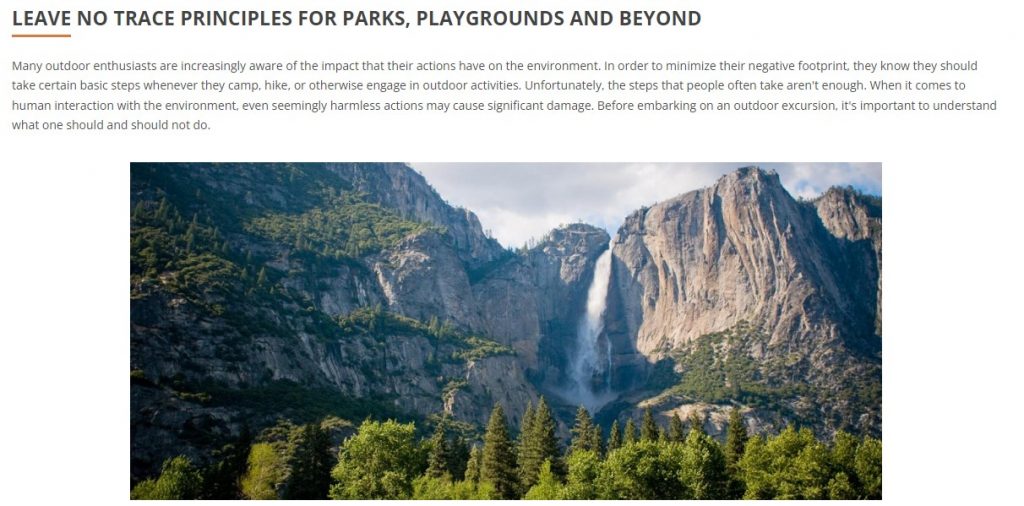
Many outdoor enthusiasts are increasingly aware of the impact that their actions have on the environment. In order to minimize their negative footprint, they know they should take certain basic steps whenever they camp, hike, or otherwise engage in outdoor activities. Unfortunately, the steps that people often take aren’t enough. When it comes to human interaction with the environment, even seemingly harmless actions may cause significant damage. Before embarking on an outdoor excursion, it’s important to understand what one should and should not do.
What Is “Leave No Trace”?
Leave no trace is a set of seven principles that minimize one’s negative impact on the environment when engaging in outdoor activities. The seven leave no trace principles are:
- Plan and prepare.
- Travel and camp on durable surfaces.
- Dispose of waste properly.
- Leave what you find.
- Minimize the impact of campfires.
- Respect wildlife.
- Be considerate of others.
People should follow these guidelines whenever they are enjoying the outdoors, regardless of whether they are engaging in activities that are reachable by car or backcountry activities that are only reachable by hiking, climbing, or boating.
 BY: CLARK CORBIN – AUGUST 29, 2022
BY: CLARK CORBIN – AUGUST 29, 2022
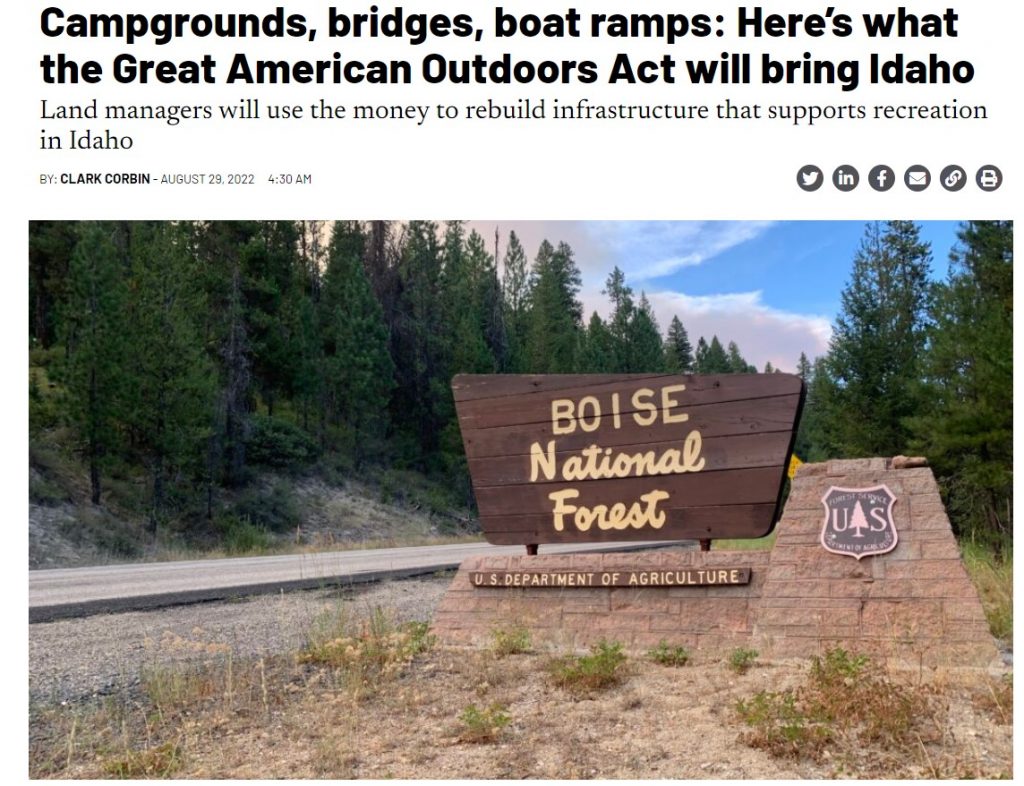 Idaho public lands and forests are in line to receive $28 million for the U.S. Forest Service and Bureau of Land Management to put toward improvements and upgrades through the first two years of funding from the Great American Outdoors Act.
Idaho public lands and forests are in line to receive $28 million for the U.S. Forest Service and Bureau of Land Management to put toward improvements and upgrades through the first two years of funding from the Great American Outdoors Act.
Enacted in August 2020, the Great American Outdoors Act is a five-year initiative that provides about $1.9 billion per year in federal funding from 2021 to 2025. Funding is split between the National Park Service, U.S. Forest Service, U.S. Fish and Wildlife Service, Bureau of Land Management and Bureau of Indian Education for projects across the country.
Public lands managers in Idaho say money allocated through the Great American Outdoors Act couldn’t be coming at a better time.
“The biggest impact from the Great American Outdoors Act, for us, is really the ability to improve recreation sites,” Bureau of Land Management Idaho State Director Karen Kelleher told the Idaho Capital Sun in a telephone interview.
“Idaho’s population is growing, and that was supercharged with COVID when a lot more people moved to Idaho and a lot more people discovered the outdoors,” Kelleher said. “The timing of the Great American Outdoors Act has been really fortuitous. We definitely had a significant backlog of work that needed to be done on recreation sites.”
For the 2021 and 2022 fiscal years, the Bureau of Land Management in Idaho has received a total of $11.4 million from the act, said Serena Baker, the BLM’s deputy state director for communications in Idaho. That money should allow the bureau to tackle 75% of its backlog of deferred maintenance at recreation sites, roads and facilities across Idaho.
“We couldn’t normally fund these projects, but it’s allowing us to do bigger projects,” Rod Collins, a deputy state director for the Bureau of Land Management in Idaho said in a phone interview.
Work in the Treasure Valley and beyond
One of the projects allows the BLM to improve the water, sewer and electrical systems at C.J. Strike Reservoir, a popular fishing destination located in Elmore and Owyhee counties that has produced three state record-breaking fish in recent weeks, Idaho News 6 reported.
The bureau will use about $1.6 million from the Great American Outdoors Act to complete repairs at the boat ramp and boat dock and improve parking at Beehive Bend, a popular recreation spot along the Payette River near the town of Horseshoe Bend. Design of the project is scheduled to begin this fall, with repairs to follow.
Great American Outdoors Act funding will also go to road maintenance, campsite improvements and brush clearing at the Wolf Flats Recreation Area east of Idaho Falls. Wolf Flats is a popular, no-fee spot along the Snake River for fishing and camping.
Bureau of Land Management officials said that having five years of funding in the law allows them to focus on the design and engineering of projects in the first couple of years and move into construction and repairs in the remaining years. Projects were chosen from a database of work orders and condition assessment of sites that were prioritized and submitted to Bureau of Land Management headquarters. The amount of funding available allows officials to focus on replacing pieces of Idaho’s outdoors infrastructure that may have come to the end of their lifespan, like water systems, boat ramps or bridges.
“The public will really enjoy the sites more and be able to enjoy them, and we will be in a position where we can maintain them,” Kelleher said.
The Sun has previously reported on some of the Great American Outdoors Act projects, including improvements and upgrades at the National Interagency Fire Center facility adjacent to the Boise Airport.
Meanwhile, officials with the U.S. Forest Service identified $7.7 million worth of approved projects from 2021 and $9.8 million in requested funding and projects for 2022, according to a U.S. Forest Service overview of Idaho project and Intermountain Region press officer Marshall Thompson.
The largest of the Forest Service’s requested 2022 projects proposes spending almost $3.5 million to reconstruct Forest Service Road 214 on the way to Redfish Lake. Another proposed 2022 project aims to spend $2.2 million to improve six campgrounds in the Sage Hen Recreation Area in the Boise National Forest, Emmett Ranger District.
Timelines for completing construction vary from project to project, and some projects will take multiple years to complete.
Projects in the Boise National Forest
- $75,000 for toilet replacements at the Buck Mountain, Troutdale and Penny Springs Campgrounds in the Boise National Forest, Cascade Ranger District.
- $160,000 for improvements at the Edna Creek Campground in the Boise National Forest, Idaho City Ranger District.
- $275,000 for replacing a timber bridge with a new prefabricated steel bridge at the East Fork Burnt Log Creek in the Cascade Ranger District on a popular road that leads to the Frank Church River of No Return Wilderness.
- $258,000 for reconstructing the water system at the Idaho City Ranger District’s housing compound used by fire and timber crews and permanent employees.
- $189,600 to reconstruct the water system at a Boise National Forest, Emmett Ranger District administrative site that also includes a cabin that is available for the public to rent.
- $275,000 for replacing the bridge Scriver Creek in the Emmett Ranger District with a nail-laminated deck that U.S. Forest Service officials said will improve safety and access.
- $53,000 for trail maintenance and signs on the Yellow Jacket, 10 Mile and Silver Creek Summit trails in the Boise National Forest.
Total: $1.3 million in approved projects.
- $58,500 for replacing the water system at the Huckleberry Campground in the Payette National Forest, Council Ranger District.
- $83,876 for trail maintenance along the South Fork Salmon River Trail in the Payette National Forest, Krassel Ranger District.
- $70,945 for rerouting sections of the French Creek and Bear Pete Ridge trails in the Payette National Forest, McCall Ranger District.
- $167,298 for replacing fire pits, picnic tables, grills, bathrooms and signs at seven developed campgrounds and several primitive campsites in the Krassel Ranger District.
- $51,800 for replacing picnic tables, fire rings, signs and kiosks at the Last Chance Campground and Hazel Lake Campground in the Payette National Forest, New Meadows Ranger District.
- $134,650 for rerouting 1.5 miles of the Little Weiser Trail in the Council Ranger District.
- $269,000 for deferred maintenance and building repairs at the Burgdorf Guard Station in the McCall Ranger District.
- $400,000 to replace the failed Jenkins Crossing trail bridge in the McCall Ranger District to restore public access to once-popular trails.
- $95,095 to repair bridges in the Council Ranger District and Weiser Ranger District.
Total: $1.3 million in approved projects.

Our ITA Youth Trail Crew Program provides opportunities for youth ages 14-18 to learn about the outdoors while building and maintaining hiking trails in a safe, teamwork-oriented environment.
Students will have the opportunity to live and work together in some of Idaho’s most wild places for a few days to up to a week at a time. Through this experience, they will build skills in teamwork and communication, as well as develop confidence in using traditional tools to perform trail maintenance. Our hope is this experience will inspire teens to become lifelong stewards and voices for their public lands and trails.
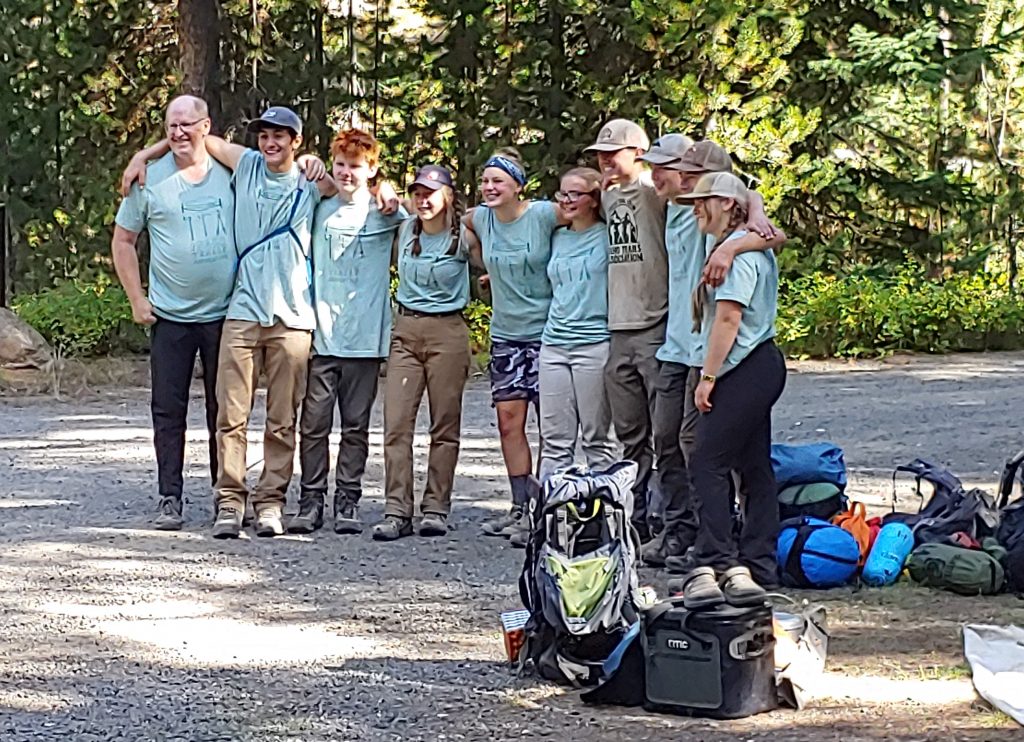
Our trips are led by experienced crew leaders who are passionate about the outdoors. These projects allow teens to meet new friends, try new things and explore Idaho’s best outdoor places.
ITA will provide all the meals and supervision for the week. Tents, sleeping bags, and pads are available. Crew leaders will have cell phones/radios in case of emergency.
Contact trails@idahotrailsassociation.org if you have any questions about our youth projects.
The Pulaski Users Group (PUG) organizes volunteer trips focused on trail maintenance, trail reclamation, and invasive species monitoring. Volunteers receive related training which equips them with the skills and knowledge to complete a variety of trail restoration projects. We aim to inspire community members to be stewards and advocates for our public lands.
We want to acknowledge that we work and live on the traditional lands of the Shoshone-Bannock People. We acknowledge that they have stewarded this land and these waters since time immemorial. We encourage you to check out this map to learn more about whose lands you are on.
The National Wilderness Skills Institute was held May 24 – 26, 2022 with training for wilderness seasonals and volunteers. You can check out sessions below.
The Forest Service and National Park Service now recognize each other’s training and certification programs. The agreement between the National Park Service and the US Forest Service has been updated to recognize that “Each Agency will accept the saw program training, evaluation, and certification conducted under the other Agency’s program for individuals working under agreement for a volunteer partner or cooperator organization on lands managed or areas administered by each Agency.”
Poudre Wilderness Volunteers Video Nominated for an EMMY
Several months ago, CBS KCNC-TV Denver aired a documentary entitled Scarred: Lessons Learned from The Cameron Peak Fire. It included several vignettes, one of which was about the work PWV is doing. As part of marketing, they teased out the documentary by airing extended versions of the vignettes prior to the actual show. The PWV story was aired first. Several of the video clips were provided by our Photo/video team and CBS was very complimentary of the quality we provided.
The 29th annual National Public Lands Day celebration will take place on Saturday, September 24, 2022. The date is different every year, but it always falls on the fourth Saturday in September.
What is National Public Lands Day (NPLD)?
NEEF’s National Public Lands Day (NPLD) is the nation’s largest single-day volunteer event for public lands. It is held annually on the fourth Saturday in September. NPLD is also a “Fee-Free Day”—entrance fees are waived at national parks and other public lands. NEEF (the National Environmental Education Foundation) coordinates National Public Lands Day.
NPLD brings together hundreds of thousands of individual and organizational volunteers to help restore the country’s public lands. These are the places Americans use for outdoor recreation, education, and just plain enjoyment. The lands encompass national parks, monuments, wildlife refuges, forests, grasslands, marine sanctuaries, lakes, and reservoirs, as well as state, county, and city parks that are managed by public agencies but belong to and are enjoyed by all of us.
Through volunteer service on National Public Lands Day as well as grant support to local organizations, NEEF helps ensure people of all ages and abilities have the opportunity to connect with public lands for recreation, hands-on learning, and community-building—now and in the future. LINK TO WEBSITE
 The Selway Bitterroot Frank Church Foundation is a community of wilderness minded and hardworking individuals dedicated to bringing citizens and youth to wilderness to work, live, and play. Since 2006, SBFC has helped steward the 4-million-acre Selway-Bitterroot Frank Church-River of No Return Wilderness, across Idaho and Montana.
The Selway Bitterroot Frank Church Foundation is a community of wilderness minded and hardworking individuals dedicated to bringing citizens and youth to wilderness to work, live, and play. Since 2006, SBFC has helped steward the 4-million-acre Selway-Bitterroot Frank Church-River of No Return Wilderness, across Idaho and Montana.
Earlier this month, U.S. Sen. Patty Murray (D-Wash.) and Washington Gov. Jay Inslee released a draft report outlining an actionable plan – and associated costs – for removing the lower Snake River dams (LSRDs) and replacing their services. The report clearly shows removing the LSRDs is not only feasible but fiscally responsible to improve the region’s long-term infrastructure and to save Idaho’s iconic salmon and steelhead. READ MORE
On a crisp, late fall day last year, less than 200 feet made all the difference on Idaho Highway 55.
Just after 2 p.m. on November 18, 2021, a traffic safety vehicle guided a line of cars through the tight construction zone in the canyon alongside the picturesque Payette River. A rumbling sound rocked the air. High above the road, tons of material crashed down from the blasted cliff face and spilled across the highway.
The slide came a mere 150 feet from crushing the Traffic-Corp pilot car and any others following behind on their way through the Central Idaho artery. It took weeks for the road to reopen to traffic.
This was the second of three major landslides that closed the corridor over the course of less than a year from March of 2021 through January, disrupting traffic between the Boise area and Valley County for days at a time. The slides all occurred within the construction zone for ITD’s ambitious multi-year project to flatten the curves of the winding, crash-prone highway snaking through the canyon.

